Katrina Kenison's Blog, page 3
March 26, 2019
dear older: I did not expect tears!
 My friend, writing colleague, and gardening expert, Margaret Roach and I touch base almost daily. Often it’s just a texted line or two, to compare notes on the weather, what we had for lunch, or what’s worth reading in the New York Times. Sometimes, though, we go deeper, in leisurely over Skype and even in that most old-fashioned form of correspondence, actual letters. On occasion over the years, we’ve tidied up our communications and shared them with our readers, a series of letters we call “Dear Old, Dear Older” (Margaret has five years on me). The imminent publication of her all-new edition of her classic A Way to Garden: A Hands-On Primer for Every Season is quite an occasion, certainly warranting more than a texted “Congrats.” And so I put some of my first impressions of the book down for her — and for you — to read. Margaret’s response to my letter is here. (All of our past correspondence can be found here.)
My friend, writing colleague, and gardening expert, Margaret Roach and I touch base almost daily. Often it’s just a texted line or two, to compare notes on the weather, what we had for lunch, or what’s worth reading in the New York Times. Sometimes, though, we go deeper, in leisurely over Skype and even in that most old-fashioned form of correspondence, actual letters. On occasion over the years, we’ve tidied up our communications and shared them with our readers, a series of letters we call “Dear Old, Dear Older” (Margaret has five years on me). The imminent publication of her all-new edition of her classic A Way to Garden: A Hands-On Primer for Every Season is quite an occasion, certainly warranting more than a texted “Congrats.” And so I put some of my first impressions of the book down for her — and for you — to read. Margaret’s response to my letter is here. (All of our past correspondence can be found here.)
Dear Older,
I was just thinking: we’ve been friends nearly a decade. Looking back at the countless hours we’ve spent together – whether it’s sipping green tea at your work table as we scribble notes and brainstorm writing ideas, or wandering through your garden in all seasons, or sharing screenshots over Skype while you manifest some small WordPress miracle on my website – I’m struck, as always, by how creative, keen-eyed, and deeply knowledgeable you are.
You wear it lightly, all this hard-won, wide-ranging wisdom — never preaching, always gently guiding, revealing, encouraging. And yet, I’d venture to say this collaborative, can-do spirit is what truly defines you. What you know, you share, be it a planting tip, a recipe for compost or tomato sauce, a seasonal to-do list, or advice about getting rid of Japanese beetles. (By hand, damn it, one at a time.) No surprise then that you’re the one I (along with your legions of fans) turn to when I need some trustworthy advice, a workaround, a reason why, or just a pair of fresh eyes on an old problem. Knowing you as I do, my meticulous, brilliant, generous friend, I was fully prepared to be impressed by the all-new edition of your gardening classic, A Way to Garden.
But honestly, Margaret, I didn’t expect to cry.
 For a book lover, there’s nothing quite like holding a fresh-off-the-press copy of a brand new title in one’s hands. And I’ve eagerly ripped into a lot of padded envelopes over the years, holding my breath till the contents are revealed — from the various works I ushered into life as an editor in the early ‘80s, through sixteen curated volumes of The Best American Short stories, and eventually on to the nervously awaited first copies of my own books.
For a book lover, there’s nothing quite like holding a fresh-off-the-press copy of a brand new title in one’s hands. And I’ve eagerly ripped into a lot of padded envelopes over the years, holding my breath till the contents are revealed — from the various works I ushered into life as an editor in the early ‘80s, through sixteen curated volumes of The Best American Short stories, and eventually on to the nervously awaited first copies of my own books.
Always, still, there’s a rush of emotion when a book is born, whether it’s a volume I’ve had a hand in publishing, the latest work of an admired writer, or a dear friend’s much-anticipated, finished-at-last project. Still, I’ve never once shed a tear over an advance copy of anything. Not until yesterday, anyway, when I sat down and began to slowly turn the pages of your beautiful new book.
Oh my goodness.
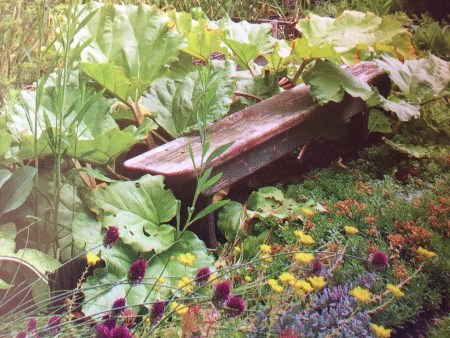 Part of this unexpected gush was surely because the physical book itself makes such a powerful first impression, stunning to behold with its lavish photos and gorgeously designed pages (kudos to your publisher on sparing no expense!), and then so intimate, encouraging, and convivial once one ventures within.
Part of this unexpected gush was surely because the physical book itself makes such a powerful first impression, stunning to behold with its lavish photos and gorgeously designed pages (kudos to your publisher on sparing no expense!), and then so intimate, encouraging, and convivial once one ventures within.
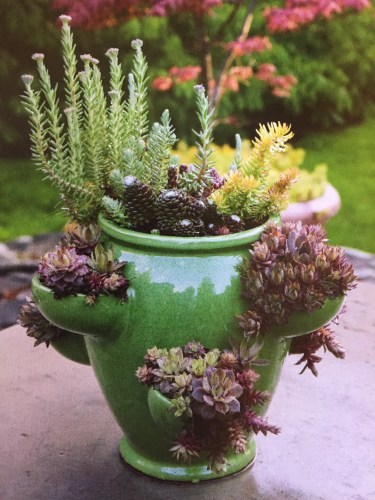 Opening to any page — be it a dramatic close-up of succulents stuffed into a strawberry jar, a handy list of germination times for favorite salad greens, or a gentle reminder to stop chasing peak moments and to the savor the little ones instead – is to hear your voice and to be right there at your side, in the garden, privy to its (and your) secrets. So maybe the sudden emotion I felt was partly relief, too. At last, it’s all right here, captured in print and stunning photographs forever — everything you have created, nurtured, learned, and are ready to pass along.
Opening to any page — be it a dramatic close-up of succulents stuffed into a strawberry jar, a handy list of germination times for favorite salad greens, or a gentle reminder to stop chasing peak moments and to the savor the little ones instead – is to hear your voice and to be right there at your side, in the garden, privy to its (and your) secrets. So maybe the sudden emotion I felt was partly relief, too. At last, it’s all right here, captured in print and stunning photographs forever — everything you have created, nurtured, learned, and are ready to pass along.
I vividly remember how magical it was to set foot for the first time into the verdant world that exists behind your deer fence, a formidable barrier that keeps foraging marauders at bay but which also encloses within its high walls an entire universe of wonders. It was October, and you led us around the back corner of the house and straight into the embrace of a venerable hundred-plus-year-old apple tree, as if facilitating an introduction between two cherished friends. And then you squatted down and set about filling a few sturdy cardboard boxes with drops. There were, it seemed, thousands of apples, both overhead and on the ground. You and the tree encouraged me to take as many as I could possibly make use of.
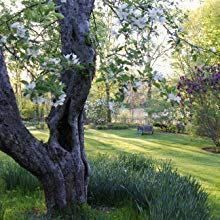 Somehow your new book, in all its visual largesse, and chock full as it is of practical advice and personal rumination, puts me in mind of that memorable day and its bounty. It’s as if every luminous photo, every tempting recipe and eloquent plant profile, every quiet reverie on change, impermanence, and the passage of time, is an offering. And, too, each page is just so much a reflection of you, you as a friend, as a writer, as a seeker, and as a gardener: open-hearted, opinionated, wise, and kind.
Somehow your new book, in all its visual largesse, and chock full as it is of practical advice and personal rumination, puts me in mind of that memorable day and its bounty. It’s as if every luminous photo, every tempting recipe and eloquent plant profile, every quiet reverie on change, impermanence, and the passage of time, is an offering. And, too, each page is just so much a reflection of you, you as a friend, as a writer, as a seeker, and as a gardener: open-hearted, opinionated, wise, and kind.
As E.B. White’s Wilbur noted upon first reading Charlotte’s latest spider-web masterpiece, “It is not often that someone comes along who is a true friend and a good writer.” To which I would add, “and a good gardener, too.” No wonder, then, that as I read through these pages and pore over the photographs, matching names at last to plants I’ve always wondered about, what I feel, all over again, is that sense of deeply rooted hospitality that first kindled our friendship. Except that now, here, it’s the essence of Margaret distilled into book form, as if you’re saying to all of us who have ever asked how deep in the soil to set the eyes of a bare peony root, or who have yearned to harvest a sweeter tomato from the vine: “Come, join me in the garden. I’ll show you.”
After I pulled myself together yesterday, I couldn’t resist the urge to find my old 1998 edition of A Way to Garden and set it down on the kitchen table alongside the updated one. Now a collector’s item, it was a much-heralded book in its day, but it is also so thoroughly of its day, which is to say, of your youth and of your garden’s earlier incarnation, too.
So, how wonderful it is that art and garden beds, unlike life, permit us an occasional do-over. And in this brand new edition, graced by twenty-one additional years of growth, reflection, trial and error, and hands-on learning, you’ve really seized your chance. A stroke of brilliance, I’d say – and probably of necessity, too, as you contemplated all that’s changed in your garden and in your thinking about plants, not to mention in the world at large, over the last two decades. (I’m so glad you talk about the climate!)
Still, this new book is so much more than a do-over. It’s twice the size, for one thing, with so much more to read and look at. I’m seeing it not as a second try at getting it right, but rather as the more evolved and expansive progeny of that very first guide, the one that started it all.
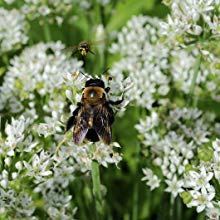 What I noticed right away, as I sat down to read more thoroughly, is not only your own ever-deepening sense of interconnectedness as you and your garden mature and grow older together, but also how your passions inspire me to look more deeply into the hows and whys of gardening myself. With each entry – from “A Moment for Lilacs” to “Putting Up a Year of Herbs” – I’m reminded of just how abundant and astonishing the natural world is when one slows down long enough to really look, and too, that I could become a more skilled and graceful steward of my own patch of ground. Your book may be first and foremost about gardening, but it’s also about gratitude, commitment, resilience, and paying attention.
What I noticed right away, as I sat down to read more thoroughly, is not only your own ever-deepening sense of interconnectedness as you and your garden mature and grow older together, but also how your passions inspire me to look more deeply into the hows and whys of gardening myself. With each entry – from “A Moment for Lilacs” to “Putting Up a Year of Herbs” – I’m reminded of just how abundant and astonishing the natural world is when one slows down long enough to really look, and too, that I could become a more skilled and graceful steward of my own patch of ground. Your book may be first and foremost about gardening, but it’s also about gratitude, commitment, resilience, and paying attention.
Perhaps one reason the new edition feels richer and more personal than the first, and even more like an extension of you, is because this time around you took almost all the photographs yourself, recording the moments as they happened – a sudden shaft of sunlight illuminating a cloud of spring crabapple blossoms, a garter snake peeking out from its niche in a stone wall, a pair of Hubbard squashes that look for all the world like an old married couple deep in conversation on a bench. Each is a poignant, indelible record of life’s fleetingness. And each reveals your affinity for this time and this place in a way no hired photographer, no matter how skilled, could ever hope to achieve. I love seeing your world through your eyes, attuned always to wonder, beauty, and evanescence. And I love meeting the friends who share your home, too, all those blessed frogs and birds and butterflies. Page by page, season by season, there you are, ready to capture and to share with us not only the stuff we need to know to succeed in our own gardens, but also the changes, both infintesimal and dramatic, that unfold on just over two lovingly tended New England acres in the course of a year.
Finally, I want to say this. Grateful as I am for the hands-on aspects of the book, I suspect I’ll return just as often to the essays you’ve written at the beginning of each chapter. These reflections, each a kind of mini-memoir, address the very themes we all wrestle with every day of our lives – how to be better humans, how to live more thoughtfully on the earth, how to create more sustainable relationships with our loved ones be they human, plant or animal, how to let go of what’s over, how to work with what is, and how to summon new faith as we step forward into whatever’s next.
“There is more to this gardening stuff than planting, I guess,” you conclude in your reflection about mending at last the decades-long distance between you and your sister. “No wonder, then, that the language of gardening and the language of life have so many words in common: words like tend and cultivate, words like grow.” Yes. Here, too, you are our guide.
You suggested (kidding, I hope!) that the reason I got all weepy when I first saw your book is because I’m old and unhinged. But that’s not it. In fact, the opposite is true. Your magnificent evocation of a life well lived, replete with passion, joy, and intense curiosity, makes me feel the very opposite of old. It reminds me how much is still possible, how much there is yet to learn, how much fun there is to be had out there in the dirt. And that if life is long and we are lucky, we might even get a chance now and then at a do-over. What a joy it is to help you celebrate the arrival, at long last, of what is surely your masterwork, the all new A Way to Garden!
Love, Old
By becoming a gardener, I accidentally—blessedly—landed myself in a fusion of science lab and Buddhist retreat, a place of nonstop learning and of contemplation, where there is life buzzing to the maximum and also the deepest stillness. It is from this combined chemistry that my horticultural how-to and ‘woo-woo’ motto derives.
On the second half of that equation, I think of my garden and myself as the two main components of the same organism. That perspective makes me think about the gardening year as roughly parallel to the six seasons of my own life, from conception through birth and on to youth, adulthood, senescence, and finally death and afterlife. Moving from phase to phase takes months or years (if all goes well) in the case of a human; in the garden, it’s all packed into a single year, and then starts over, and over, even long after the gardener is gone.
—Margaret Roach
pre-order a book. . .
And get a ticket for a free webinar with Margaret on April 2 or 4, or an in-person lecture on May 11 when her garden in Copake Falls will also be open to visitors. All about this special offer here.
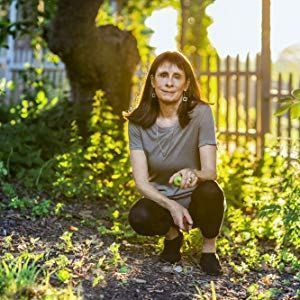
Can’t make it on May 11? Margaret is lecturing around New England and opening her garden on several other summer weekends this year. Check out her complete schedule of events here.
or, if you just want your own copy asap . . .
Simply place an order now with your local bookstore, or pre-order here for delivery on publication day, April 30. A Way to Garden will be my go-to gift for Mother’s Day this year, so I’ll be purchasing multiple copies. You might want to do that, too! (Note: this is an Amazon affiliate link.)
The post dear older: I did not expect tears! appeared first on Katrina Kenison.
March 10, 2019
an everyday thing
“What is happiness except the simple harmony between a person and the life they live?” ~ Albert Camus
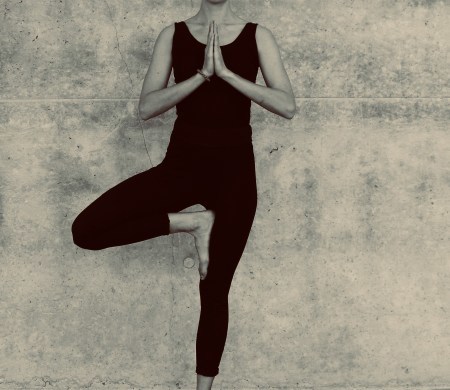 I have a friend who rose before dawn for six hundred days in a row. On every one of those mornings he took a cold shower, practiced a Kundalini yoga kriya, and exhaled a hundred vigorous Sat Nams into the dark. Along the way, he reported, he fell back in love with his life. He lost weight, found contentment, parented three kids and took a second job. He began teaching yoga himself and wearing white.
I have a friend who rose before dawn for six hundred days in a row. On every one of those mornings he took a cold shower, practiced a Kundalini yoga kriya, and exhaled a hundred vigorous Sat Nams into the dark. Along the way, he reported, he fell back in love with his life. He lost weight, found contentment, parented three kids and took a second job. He began teaching yoga himself and wearing white.
His dedication to the spiritual path was inspiring. The only things I’ve ever managed to do every day are brush my teeth and make my bed. My husband flosses seven nights a week. I try, but sometimes, for no good reason, I just skip it.
A decade ago, because I adored the teacher and because I was impressed by my friend’s dramatic transformation, I enrolled in a local Kundalini yoga teacher training and made my own commitment to cold showers and pre-dawn yoga practice. Getting out of a warm bed in the chilly darkness, leaving my sleeping husband and dog, gasping as the icy water hit my body at 4:30 in the morning, wrapping a white cotton scarf around my head before doing fifty squats and chanting mantras, I felt empowered but also tired and a little silly. Give it time, I told myself. You’ll get used to it. I didn’t.
Although the training was just one long weekend a month for ten months, the three-minute cold showers and pre-dawn yoga were meant to become daily lifelong rituals. I gave it a good try. Yet while my classmates reported emotional breakthroughs, newfound calm, and moments of epiphany, I felt increasingly resentful and exhausted and ridiculous. Also, I felt like a failure, by turns fraudulent and peevish, annoyed that this thing I had committed to doing seemed more like a ball and chain in my life than a liberation of my spirit.
Why, I wondered, did a routine that forms the basis of an entire school of yoga, one intended to calm your mind and energize your body, make me so miserable? I loved so much about that introduction to Kundalini yoga – the ethereal music, the chants, the energizing Breath of Fire, the sequences that were said to clear old hurts and scars and heal the endocrine system, and the spicy black tea we students sipped together after practice. But I also realized I was never going to become a Kundalini yogi. My entire system rebelled. I wanted to wake up with my husband, not an hour and a half before him. I wanted a hot shower. I felt uncomfortable with my head swaddled in a turban. I wanted to move my body in ways that felt supportive and good, not according to a sequence of poses written down years ago by someone who didn’t know me.
Most of all, I didn’t want to do anything every single day. Humbled, struggling to accept myself as a person lacking the self-discipline required for spiritual enlightenment or rigor, I left the training two months before it ended, rolled up my white headscarf and tucked it away in a drawer, and returned to my old weekly yoga class.
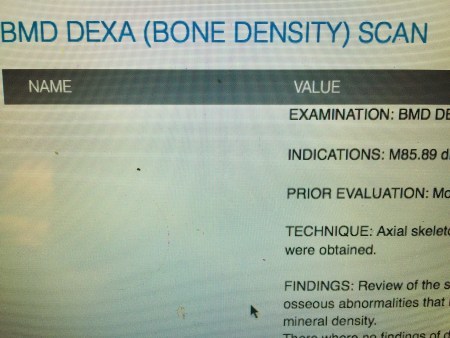 I had my first Dexa scan three years ago, a few weeks before my first hip replacement. The results, I was told in an email from my doctor’s office, could be found by logging into a patient portal: osteopenia. At the time, the news that my bone density was lower than normal seemed like the least of my worries. A dear friend had just died. I was preparing for two major surgeries. My doctor didn’t seem to think the condition warranted so much as a conversation, let alone an office visit. I made a mental note to think about buying some hand weights once my two new hips were in place and went back to reading about post-op PT. I barely gave osteopenia another thought
I had my first Dexa scan three years ago, a few weeks before my first hip replacement. The results, I was told in an email from my doctor’s office, could be found by logging into a patient portal: osteopenia. At the time, the news that my bone density was lower than normal seemed like the least of my worries. A dear friend had just died. I was preparing for two major surgeries. My doctor didn’t seem to think the condition warranted so much as a conversation, let alone an office visit. I made a mental note to think about buying some hand weights once my two new hips were in place and went back to reading about post-op PT. I barely gave osteopenia another thought
In November, realizing I’d met my insurance deductible for the year, I asked my doctor if it might be a good idea to recheck my bones. She’d never mentioned it again, and it wouldn’t have occurred to me to request a follow up had the test not been covered by insurance. This time, I got a phone call to come in to her office for the results.
“You have osteoporosis,” the doctor said mildly, without looking up. “A considerable amount of bone loss, which puts you at a high risk for fragility fractures, which are breaks that happen spontaneously, without any warning. I’ll write you a prescription. You can take this medication for four years. After that, we don’t recommend you continue because there are side effects with long-term use.”
I didn’t know much about osteoporosis at that point. But sitting there, absorbing this news as she stared at her computer, I did know one thing: my doctor was not seeing a person in front of her whose life expectancy had just grown dramatically shorter, she was seeing some numbers on a screen. She would be happy to write me a prescription, but she had no interest in the long-term health of my bones. Or in me. I was going to have to become my own student of bones.
Back at home, I scooped some yogurt (calcium!) into a bowl, switched on my laptop, and dove into my new assignment. If you’ve ever turned to Google to learn more about something happening in your body, you know: for every scrap of advice you turn up, there seems to be some other opinion that contradicts the first. But when it comes to bones there are quite a few facts that are universally agreed upon, from the mortality rates of hip fractures and the sobering statistic that one out of two women over fifty will experience an osteoporosis fracture in her life, to the importance of vitamin D, calcium-rich foods, and regular weight-bearing exercise.
To me the biggest surprise was that I had become so porous so fast, a fracture waiting to happen. I’d been pretty sure I was already taking good care of my bones. I exercise and practice yoga. I do eat well. I take a walk most days and turn my face to the sun. And yet, according to the numbers, my 60-year-old bones are equivalent in mass to those of an average 85-year-old woman. In three short years, I’d lost 27% of the bone density in my wrist and forearm. I was at risk for more bone loss, fragility fractures, and kyphosis. Suddenly, the possibility of a slip in the kitchen or a fall on the ice had become terrifying.
When I first sat down with my Dexa scan results in front of a website that helped me translate all the various measurements, I went from shock and disbelief to anger. Why had the doctor completely ignored the osteopenia three years earlier? Why had no physician ever talked with me in the past about my own high risk for osteoporosis and how to prevent it?
Would I have listened? If I’d known twenty years ago, at forty, what I now know at sixty, could I have avoided this condition altogether?
I suspect the answer to that last question is yes. There is so much I could have done, had I only known what to do. I also realize there’s no point in looking back with self-reproach to all the collard greens and almond butter I didn’t eat, the weights I didn’t lift, the Vitamin D I didn’t take.
But I feel certain I made the right call when I walked out of the doctor’s office that day without a prescription in my hand and went in search of another path.
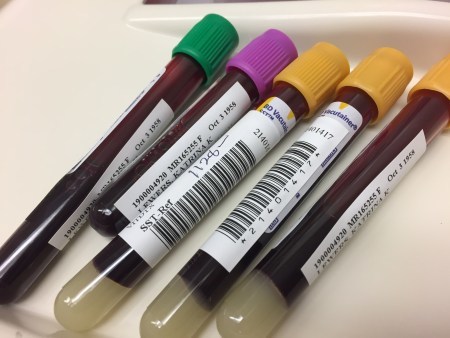 Over these last few months, I’ve had so much blood drawn for further tests that the lab at the hospital sent me a “thank you” card signed by all the members of the staff. (When you get an osteoporosis diagnosis, the first thing you want to do is have some other things checked, especially your thyroid and Vitamin D level.) I’ve read a whole stack of books by doctors and chiropractors and nutritionists. I’ve spent countless hours on line and compared notes with friends who are in the same boat I am, our zest for life and our sense of ourselves as healthy and strong butting up against the reality of our fragile skeletons.
Over these last few months, I’ve had so much blood drawn for further tests that the lab at the hospital sent me a “thank you” card signed by all the members of the staff. (When you get an osteoporosis diagnosis, the first thing you want to do is have some other things checked, especially your thyroid and Vitamin D level.) I’ve read a whole stack of books by doctors and chiropractors and nutritionists. I’ve spent countless hours on line and compared notes with friends who are in the same boat I am, our zest for life and our sense of ourselves as healthy and strong butting up against the reality of our fragile skeletons.
Bones, it turns out, are amazingly complex living structures that require knowledgeable care and feeding from many different sources. And it’s never too late to start making them stronger and healthier.
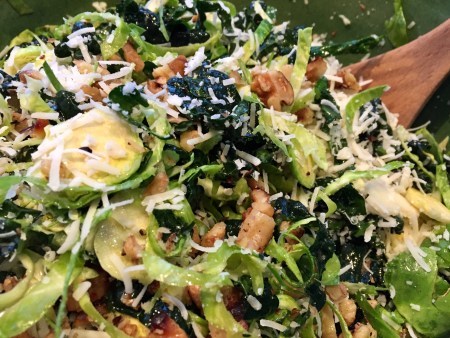 I’ve learned a lot about who’s most at risk for osteoporosis (white, thin, small-boned, fair-skinned, post-menopausal, women like me, for starters), why bones become brittle and how spontaneous fractures happen, why this condition, although invisible and painless until fractures occur, can’t be ignored, and how medication, though sometimes necessary, creates its own set of risks and problems. I’ve changed doctors and I’ve changed my diet. (I do not come home from the grocery store without brussels sprouts, bok choy, kale, almonds, and figs.) I’ve started a regime of supplements and vitamins. I’ve also changed the rhythm of my days, the way I spend my time, and even my attitude about being alive and growing old.
I’ve learned a lot about who’s most at risk for osteoporosis (white, thin, small-boned, fair-skinned, post-menopausal, women like me, for starters), why bones become brittle and how spontaneous fractures happen, why this condition, although invisible and painless until fractures occur, can’t be ignored, and how medication, though sometimes necessary, creates its own set of risks and problems. I’ve changed doctors and I’ve changed my diet. (I do not come home from the grocery store without brussels sprouts, bok choy, kale, almonds, and figs.) I’ve started a regime of supplements and vitamins. I’ve also changed the rhythm of my days, the way I spend my time, and even my attitude about being alive and growing old.
One of my first internet searches was “yoga and osteoporosis.” One click, and I was ordering Dr. Loren Fishman’s groundbreaking book Yoga for Osteoporosis, which offered exactly the encouragement I was desperate to hear: namely, it is possible to treat osteoporosis, in part, with the thing I like to do most. According to Dr. Fishman’s research, a regular practice of a series of twelve classical poses has been proven to strengthen bones and help prevent fractures. (He’s done a clinical study. It works. YAY!)
What I didn’t quite grasp, until my friend Maude and I took a fortuitously timed weekend workshop with Dr. Fishman at Kripalu Center for Yoga and Health a few weeks later, was that just going through the motions wouldn’t build our bones. Therapeutic yoga poses for osteoporosis have to be done every day, seven days a week, for maximum benefit. Poses have to be held, ideally, for a full minute. Held with full-on effort, precise alignment, and maximum resistance. Held with every muscle engaged, every breath complete, every ounce of intention and energy summoned and brought to bear while you work harder at your yoga practice than you have ever worked before. (Gentle yoga? Forget it.)
For two days, we repeated the same twelve familiar yoga poses with every possible modification. We held them as if our lives depended on it, which, in a way, they do. We left on Sunday afternoon exhausted and exhilarated and hopeful, and feeling the very opposite of fragile.
“By our sixties,” Mary Pipher writes in her illuminating, insightful new book Women Rowing North, “we may think the way we did in our forties, but our bodies don’t act that age. Intimations of mortality can make us sad and fearful, but they can also wake us up. Until we understand how short life is, many of us make the mistake of thinking our routines will go on forever.”
Since turning fifty, I’ve lost three close friends who didn’t make it to sixty. Each of these dear women, in her own way, approached the too-soon end of life by finding deeper satisfaction in the small pleasures and unexpected moments of grace that are so easily missed or taken for granted in our mindless rush to get to the next thing. Each of them transformed their initial “Why me?” reaction to a terminal diagnosis into a philosophical “why not me?” acceptance of the truth: that life is random and death inevitable, that tragedy is universal, that good health is not a given, and that each moment that we’re still here on the planet with our loved ones is a gift. When death draws near, we see at last what really matters. We have an opportunity to approach what time is left with more awareness, intention, and gratitude. Suddenly we can choose to live as if the moments, the days, the years really count. I sensed that myself as I blew out the candles on my birthday cake last fall: there’s no more time to waste.
I still feel like a beginner at being old. But I learned so much about how precious life is, and how ephemeral, from my friends who are no longer here. “Live your life,” my friend Diane urged me during many of our final conversations. She wanted me to write my books and to spend time with my family, to travel and to keep climbing mountains. She wanted me to carry on after she was gone in a way that wouldn’t ever give rise to regret for moments missed or love unspoken.
“You have osteoporosis,” is not good news to receive, but it’s a far cry indeed from a terminal diagnosis. I am just one of the eight million other women in this country with low bone density. For me, however, this new reality has been a wake-up call.
This diagnosis has brought home to me, in a way that even three years of arthritis pain and two hip replacements did not, the fact that life is finite and so am I. It has revealed that my body and I (“I” being that voice inside my head) are in a partnership, and that we must work together for the greater good of us both for as long as we are able. Osteoporosis has given me no choice but to take charge of my own health, to learn all there is to know about how to take better care of myself, and to make well-informed choices about what medications and supplements I take, what I eat, and what I do.
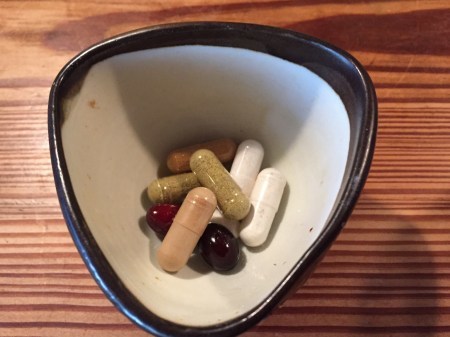 I would like to live for a long time – to live without cracking a rib when I sneeze, without losing an inch of my height, without rounding forward with a succession of hairline spinal fractures, without fear of getting hurt.
I would like to live for a long time – to live without cracking a rib when I sneeze, without losing an inch of my height, without rounding forward with a succession of hairline spinal fractures, without fear of getting hurt.
Of course, I also want to live without giving up the things I love to do. And this is where surrender comes in. Adjustments must be made. And so I’m learning that, with the right attitude, letting go is possible. I may not run or shovel snow or do forward folds and headstands anymore, but perhaps the very fact that I must give up a few things allows a deeper sense of gratitude for all that’s left, which, at this point is plenty. I do take extra care walking across the driveway after it’s snowed, but I can also put on my IceSpikes and hike up the mountain with ease. I can return a backhand to my husband on a (clay) tennis court. The day will come when these physical activities, too, will be a memory. My hope is that by then I’ll have grown more skilled at this task of accepting what can’t be changed.
As I watch my parents, both in their eighties, greet each day with good cheer and appreciation, I realize how much they still have to teach me — lessons of fortitude, resilience, and grace. Their own health issues are never far from any of our minds, and yet they do what they can with joy and good humor. This week, I’m with them in Florida, savoring the pleasure of being nothing but a daughter. Each morning, we gather in the living room and I guide my mom and dad through a yoga practice; for an hour or so they are my willing students, breathing their bodies into unfamiliar shapes and places, stretching muscles they had forgotten they even possessed. The learning, if our hearts and minds are open, can flow both ways.
“We shouldn’t be taking all this time out of your day,” my dad protested yesterday. On the contrary. My father is a man who feels naked without his shoes and socks on. To watch him lift and spread his bare toes, inhaling and exhaling, trying something brand new at age eighty-three, is both a delight and a memory to be stored. There is nothing I’d rather be doing.
Maybe this is how enlightenment works. You get the wake-up call, the clunk on the head, the message that is too loud and too insistent to ignore. And then you have a choice. You can turn away and go back to sleep, or you can dive in deep and allow the current of your life to carry you to places you never expected to go. As the time in front of us grows shorter, life’s beauty comes into sharper focus. There is something energizing about seeing the truth of one’s own mortality more clearly.
These days, I’m more aware than ever before that the moments I spend with the people I love are to be treasured not squandered. I’m more grateful than ever before that I am fit enough to climb that mountain, to take a nine-mile hike, to sweat it out for thirty minutes on the elliptical machine at the gym. In deference to my bones’ need for exercise, I actually find myself sitting less and moving more. (That does also mean writing less, alas, at least for now.)
And there is this. Ten years after my failed attempt at pre-dawn cold showers and Kundalini kryas, I’m doing something I never thought I could: thirty minutes of intense, challenging yoga a day. Every day. I stand in tree pose, unwavering, for a minute, breathing steadily. I am stronger than I’ve been in years. I’m not quite ready to say that my low T score was a gift, but it may turn out to be.
some resources
If you wish to strengthen your bones with yoga, Dr. Loren Fishman’s Yoga for Osteoporosis is your bible. There’s also a YouTube video to get you started. Work hard. Wrap your muscles around your bones. Hold the poses.
The best book I’ve found about the science of osteoporosis, what steps to take if you’re diagnosed, and the general care and feeding of your bones is Dr. Keith McCormick’s The Whole-Body Approach to Osteoporosis. Grab your highlighter.
Dr. Lani Simpson’s No-Nonsense Bone Health Guide is an invaluable resource packed with advice and encouragement. Also, she offers a comprehensive discussion of calcium supplementation and how to do it right.
In a holistic approach to healing, your kitchen is your pharmacy. Start feeding your bones (and learn what foods to avoid) with Annemarie Colbin’s The Whole-Food Guide to Strong Bones.
I swore I would buy no more cookbooks, but I did succumb to The Healthy Bones Nutrition Plan and Cookbook by daughter and mother team Dr. Laura Kelly and Helen Bryman Kelly. Lots to chew on here, with 100 practical, inspiring, tasty recipes.
Finally, I can’t recommend Mary Pipher’s Women Rowing North: Navigating Life’s Currents as We Age highly enough. Although Mary claims to have written this book specifically for women crossing from middle age into old age (if we’re being literal, that means anyone over 50, right?), her wisdom and insight into change, loss, and growth are welcome no matter how old you are. She’s the kind of writer who feels like a friend. I found myself on every page.
The post an everyday thing appeared first on Katrina Kenison.
January 19, 2019
reasons to hope
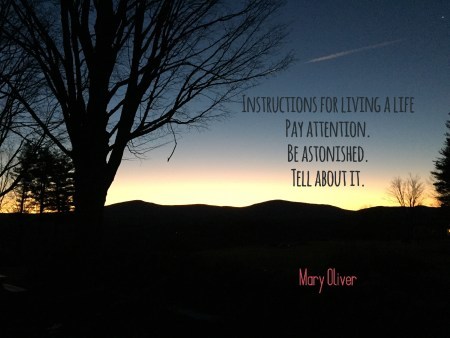 “Keep some room in your heart for the unimaginable.” ~ Mary Oliver
“Keep some room in your heart for the unimaginable.” ~ Mary Oliver
Shortly before Christmas, on the raw, drizzly night when my son Henry and I bought the last fraser fir left at our local Agway, I also purchased a tangled bundle of bare branches adorned with shriveled red berries. Their austere beauty suited my mood, more so than the tiny bottlebrush trees and angel figurines I usually unpack right after Thanksgiving.
The last few months have been challenging. One of the reasons I’ve been quiet here is that struggles are hard to write about, especially during the holidays, when the world is bent on uplift and good cheer. Having failed to summon much advance holiday spirit myself, I put off decorating for so long that the local farm where we’d planned to cut down a tree had already sold out their crop for the year by the time we got there. At the eleventh hour, though, we lucked out. The tree that happened to be the very last tree left at Agway also happened to be perfect, not too tall and beautifully proportioned. I wandered around the yard the next day, clippers in hand, and cut boughs of pine and hemlock and rhododendron to mix in with the berries and put them in pitchers around the house. At the grocery store, white roses were on sale for five dollars; I bought some of those, too. Most of the rest of our decorations, collected over decades, remained in the basement. I don’t think anyone really missed them.
For a week in December, everyone was home. As the house filled with family and as Christmas Day arrived, so did joy. Meals were made and cleaned up after, walks were taken, fires were lit, loads of laundry and dishes were done. No one was tempted to talk about politics (we all needed a break). There were no peak moments, just a string of small, good ones. And no one took anything for granted, not the presence of grown children arriving from Cincinnati, Asheville, and Atlanta, nor the presence of my parents who, in their eighties, continue to meet the challenges of aging with good humor and grace. One of my favorite Christmas gifts came from Henry: an hour of piano music, which I cashed in on the night before New Year’s Eve. My mom came over that evening, we had a fire, and Welsh rarebit for dinner, and we all sat in the living room listening to a lovely, eclectic concert – from Rachmaninoff to Keith Jarrett — offered with love and played from the heart. Melted cheese and live music are an excellent combination. “I don’t want this to ever end,” my mom said in the moment of stillness after the first song. I felt the same.
Recently I read a quote on a friend’s blog, words from soul-centered business coach Hiro Boga that so aptly summed up my experience lately that I’ve been turning the words over in my head like a mantra ever since:
“Sorrow in one hand, joy in the other. Being human is a prayer.”
Somehow this simple reminder that life is never either /or, but always both, has brought me some needed reassurance throughout these first weeks of 2019. If I can let go of my desire to change or fix things, my own prayer becomes not a plea for life to be different but rather a bow to life as it is – at once dark and light, beautiful and hard, precious and messy, full of goodness and, too, ineluctably tinged with sadness, change, and loss.
It didn’t take long to pack Christmas away last month. By the time Henry and I got to the last tune on the “This Is Us” Spotify playlist, we had the tree stripped and he’d dragged it out to the burn pile in the field. The boxes of ornaments were back in the cellar and the floor was vacuumed. Empty and clean, the rooms seemed to exhale into spaciousness. Much as I love having a house full of people, I was also relieved it was all over.
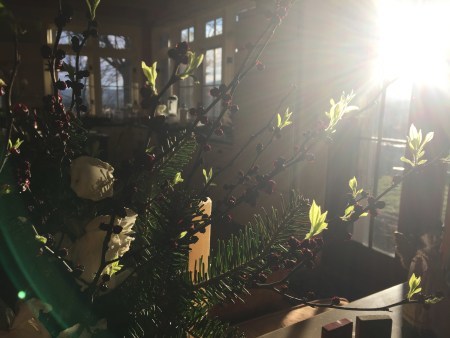 That night, as I went to grab the greens from the pitcher in the dining room, I stopped in surprise. There, amid the desiccated berries, were tender green leaves sprouting forth. Expecting to toss out something dry and dead, what I found instead was the insistent wonder of new beginnings. The white roses, slumped amid the evergreens, struck me as equally beautiful. Gone by, yes, but aged now to ivory, soft and subtle as vintage silk. A couple of random petals, fallen from their blooms, were nestled among the pine needles as if placed by a decorator’s hand. Without my even noticing, the hasty arrangement I’d cobbled together before Christmas had transformed itself in the new year into an altogether different composition – a subtle revelry of releasing and renewing.
That night, as I went to grab the greens from the pitcher in the dining room, I stopped in surprise. There, amid the desiccated berries, were tender green leaves sprouting forth. Expecting to toss out something dry and dead, what I found instead was the insistent wonder of new beginnings. The white roses, slumped amid the evergreens, struck me as equally beautiful. Gone by, yes, but aged now to ivory, soft and subtle as vintage silk. A couple of random petals, fallen from their blooms, were nestled among the pine needles as if placed by a decorator’s hand. Without my even noticing, the hasty arrangement I’d cobbled together before Christmas had transformed itself in the new year into an altogether different composition – a subtle revelry of releasing and renewing.
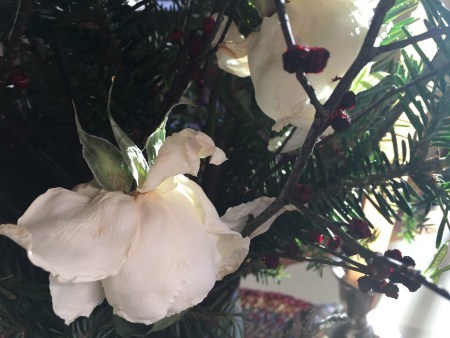 Those small, unasked for leaves are not much in the grand scheme of things. Stick a bare branch in water, and it will have a go at life. And yet the sight of them now, still thriving during these final days of January, lifts my spirits immeasurably. This is what hope looks like.
Those small, unasked for leaves are not much in the grand scheme of things. Stick a bare branch in water, and it will have a go at life. And yet the sight of them now, still thriving during these final days of January, lifts my spirits immeasurably. This is what hope looks like.
And hope is what I’m choosing to carry forth into 2019.
I’ve always resisted the notion of adopting a word for the year and I didn’t expect to give in this year. But it seems my word has chosen me, and now that I have it, I’m not letting go.
To be an informed, engaged citizen of the world at this time is to live with a level of sadness, helplessness, and anxiety unlike anything I’ve known in my own lifetime. There are no quick fixes or easy answers, not for the small cares and concerns that darken my own thoughts, nor for the crises we face as a country, nor for the suffering in the world or the relentless human assaults upon our planet.
Yet something in my heart seems to have shifted. If there’s joy in one hand and sorrow in the other, then hope is the prayer that bridges the distance. Hope doesn’t mean the facts have changed. But the difference between hope and despair may turn on the story one creates with those facts. Hope is a kind of reframing. It has nothing to do with wishing and everything to do with seeing the truth through fresh eyes. Hope is a tilt of the head, a different perspective, a glass half full, a pair of spectacles with rose-colored lenses. Hope depends on a kind of stubborn willingness to recognize the possibilities and challenges buried within the present moment, no matter how dire it may seem, and to welcome those tiny scraps of potential goodness with faith and an open heart.
And so, I’m inviting hope to guide me forward. And I’m tuning my eye to see reasons for hope, no matter how small or random or unlikely they might be.
Look well to the growing edge! All around us worlds are dying and new worlds are being born. All around us life is dying and life is being born. The fruit ripens on the tree; the roots are silently at work in the darkness of the earth against a time when there shall be new leaves, fresh blossoms, green fruit. Such is the growing edge! … This is the basis of hope in moments of despair, the incentive to carry on when times are out of joint and people have lost their reason, the source of confidence when worlds crash and dreams whiten into ash. . . . Look well to the growing edge!
— Howard Thurman
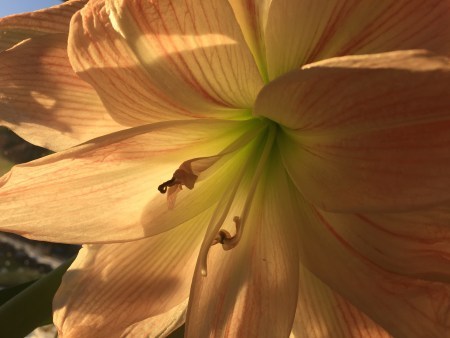 This amaryllis, sent by a dear friend three years ago as I prepared for hip surgery, is blooming once again, magnificently, after spending the summer dormant and ignored in a dark outside corner and a few autumn months stashed in a chilly closet. Water and sunlight was all it took for green shoots and spectacular blossoms to return. The mystery of life is reason to hope.
This amaryllis, sent by a dear friend three years ago as I prepared for hip surgery, is blooming once again, magnificently, after spending the summer dormant and ignored in a dark outside corner and a few autumn months stashed in a chilly closet. Water and sunlight was all it took for green shoots and spectacular blossoms to return. The mystery of life is reason to hope.
Such is the growing edge.
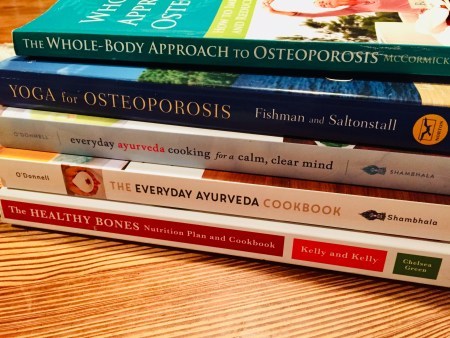 A brilliant book and an inspiring weekend workshop on yoga for osteoporosis have given me reason to hope that this dreaded diagnosis, so unexpected and scary, is also an opportunity for me to stretch and learn. I’m improving my diet, becoming a student of bones, transforming my yoga practice, and choosing a whole-body approach to healing. Here’s to fish oil and calcium supplements, prunes and dandelion greens. Here’s to a commitment to get strong and to share the fruits of this path with others. Reaching out my arms in warrior pose, it occurs to me that growing older can also mean growing smarter.
A brilliant book and an inspiring weekend workshop on yoga for osteoporosis have given me reason to hope that this dreaded diagnosis, so unexpected and scary, is also an opportunity for me to stretch and learn. I’m improving my diet, becoming a student of bones, transforming my yoga practice, and choosing a whole-body approach to healing. Here’s to fish oil and calcium supplements, prunes and dandelion greens. Here’s to a commitment to get strong and to share the fruits of this path with others. Reaching out my arms in warrior pose, it occurs to me that growing older can also mean growing smarter.
Such is the growing edge.
Eight months after a trauma to his ears left him with acute, often debilitating tinnitus, my son Henry struggles daily to hold on to hope. Only someone who has lost the possibility of silence can fully appreciate just how precious that silence is. For a musician, for someone who values the empty spaces between the notes as much as the notes themselves, this loss is devastating. Henry can attempt to quiet the despairing voice in his mind, but there is nothing to still the incessant ringing in his left ear.
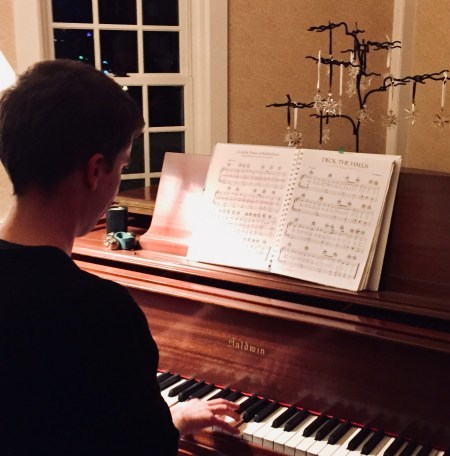 To say that every step of this journey has been hard doesn’t begin to convey just how hard it is, day in and day out. At times it is unbearable. And yet, even though there is no cure, there is still reason to hope. My own hopes for his future with this condition won’t be realized in any dramatic fashion, but perhaps they will manifest invisibly, slowly, over time. We can hope for resilience and equanimity, for courage and determination, for peace of mind. Meanwhile, I see hope right now in my son’s redoubled commitment to conducting and to playing the piano, despite how much more difficult this work he loves has become. There is reason for hope in his new meditation practice, in his reading and writing, in his dedication to yoga and exercise, to self-care and self-acceptance. I see hope, too, in his willingness to ask for help and to share the truth of his feelings. And in his will to move forward, even when forward feels all uphill. Yesterday, he began taking private jazz piano lessons, after quite a few years of focusing on the musical theatre repertoire. “How was it?” I texted last night. “It was good!” he typed back. “He threw a lot of stuff at me that’ll help me get my jazz chops back up again. It’s all still there, but it’s been dormant for a while.” For a worried mother, the quiet excitement behind those words is reason to hope.
To say that every step of this journey has been hard doesn’t begin to convey just how hard it is, day in and day out. At times it is unbearable. And yet, even though there is no cure, there is still reason to hope. My own hopes for his future with this condition won’t be realized in any dramatic fashion, but perhaps they will manifest invisibly, slowly, over time. We can hope for resilience and equanimity, for courage and determination, for peace of mind. Meanwhile, I see hope right now in my son’s redoubled commitment to conducting and to playing the piano, despite how much more difficult this work he loves has become. There is reason for hope in his new meditation practice, in his reading and writing, in his dedication to yoga and exercise, to self-care and self-acceptance. I see hope, too, in his willingness to ask for help and to share the truth of his feelings. And in his will to move forward, even when forward feels all uphill. Yesterday, he began taking private jazz piano lessons, after quite a few years of focusing on the musical theatre repertoire. “How was it?” I texted last night. “It was good!” he typed back. “He threw a lot of stuff at me that’ll help me get my jazz chops back up again. It’s all still there, but it’s been dormant for a while.” For a worried mother, the quiet excitement behind those words is reason to hope.
Such is the growing edge.
The truth is, it’s taken me the whole, long, frozen month of January to really embrace my word. At first, I wasn’t sure I had it in me. To declare hope as a way of life during difficult times sounds a bit dramatic and foolishly romantic, I know. Yet to see only the worst in any given moment denies my own capacity to make things better. If the tapestry of human history is woven through with threads of cruelty, thoughtlessness, and tragedy, it is also a long, astonishing story of compassion and courage, acts of kindness, and works of goodness large and small. Not to mention the occasional miracle. To embrace hope isn’t to deny reality but rather to acknowledge it and, at the same time, to shift focus from what is wrong to what is possible. What we choose to emphasize, right here, right now, is what determines the shape of our experience, the tenor of our days, the direction of our lives. If hope is a muscle, surely I should be able to strengthen mine.
I was sitting in my kitchen Thursday morning, trying to put these thoughts into words, when a text from my husband arrived with the news that Mary Oliver had died. Suddenly the gray sky beyond my window seemed a little darker, my own world emptier, as if a dear friend had left the room. If ever there was a writer who knew how and where to look for hope, it was she. To escape her abusive father and neglectful mother, she turned as a young child to the solace of nature, and to the possibility of creating her own inner landscape of wonder and beauty as a bulwark against the bleak and dangerous reality of her home life. Hope for Mary Oliver was infused with gratitude, with wonder, with a deep appreciation for the outdoors, for dogs and birds and wild animals, for sunsets and sunrises and all kinds of weather, for romantic love and spiritual ecstasy, and perhaps most of all, for the beauty and the potential of the moment at hand. “My work,” she said, “is loving the world.”
That is my work, too. And yours. And ours. May hope become not just a word, then, but a calling; not just a choice but a practice. To love the world is to do our own small part to honor and protect it. Joy in one hand, sorrow in the other, and hope as the energy that allows us to move more gracefully and purposefully through life as it is, not as we wish it to be.
Look around. What gives you reason to hope, right now?
The post reasons to hope appeared first on Katrina Kenison.
November 6, 2018
this is 60
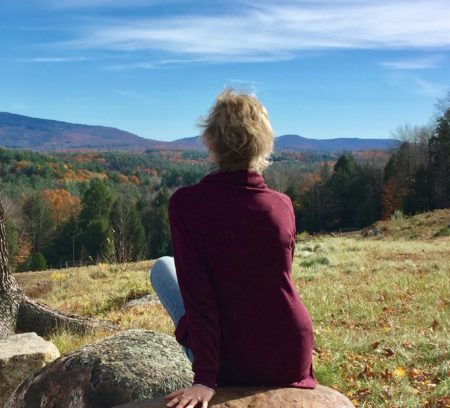 Sixty is not middle-aged. Not even close. Sixty is a reckoning with the truth of mortality, with change, with a new sense of myself as finite.
Sixty is not middle-aged. Not even close. Sixty is a reckoning with the truth of mortality, with change, with a new sense of myself as finite.
Sixty is an expanded awareness of time passing. It’s wondering where the years went and, too, marveling at the breadth and depth of the journey — past, present, future. Sixty is standing on a threshold, contemplating the beginning of the end. To reach this place, alive and relatively unscathed, feels like both serendipity and blessing. Sixty is a more respectful understanding of fate. It’s the small but real comfort of being the youngest of the old. Sixty is a chapter between mid-life and old age, a chapter that has no name.
Sixty is twenty times three. Twenty more than forty, which sounds like a lot. And twenty less than eighty, which sounds like too little. It’s a number. Still, I can’t quite believe it’s my number. Sixty on the inside doesn’t feel very different from fifty, but sixty as the age I am now takes some getting used to. Still, sixty is quite different today than it was a generation or two ago. My sixty is not my grandmother’s sixty.
Sixty is facing the fact that my youth really is over. (I thought I’d faced it a while ago, but I guess I hadn’t. Not quite.) It’s coming to fully appreciate that those of us who grow old are the lucky ones. And it’s realizing how little I actually know about getting old. It’s pausing to think of the friends who didn’t make it, who will never be sixty, who are missing these surpassingly lovely autumn days. Sixty is about doing my best to live for them, too. It’s remembering their birthdays and their death days and the togetherness we shared along the way. Sixty is about trying, somehow, to hold on to all the years and ages that came before. It’s about accepting that they’re already gone, sifted through my fingers like sand.
Sixty is a constantly shifting landscape of diminishments and benefits, losses and gains. The losses are dramatic and obvious (think death and beauty) while the gains are often invisible but no less dramatic for that. Sixty is an appreciation for the moment at hand, because I know it won’t last. It’s a greater ease with things as they are, because I know they will certainly change. It’s delight in simple pleasures and other people’s joys and successes. Sixty is less drama and more contentment.
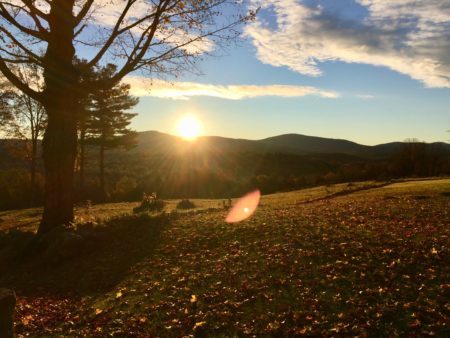 Sixty is the sweetness of waking up in the dark, spooned close to my mate of thirty-one years. It’s stepping outside with the dog into chill morning air just as the sun slips into view. It’s swirling cream into a mug of strong coffee, taking a walk, receiving a hand-written card in the mail. It’s a plane trip to visit a son in grad school and an hour on the porch with my mom, the reassurance of connection, caring, and the long, complicated tapestry that is one family’s history – a tale in which we are but single threads woven through our tiny portion of the vast human whole.
Sixty is the sweetness of waking up in the dark, spooned close to my mate of thirty-one years. It’s stepping outside with the dog into chill morning air just as the sun slips into view. It’s swirling cream into a mug of strong coffee, taking a walk, receiving a hand-written card in the mail. It’s a plane trip to visit a son in grad school and an hour on the porch with my mom, the reassurance of connection, caring, and the long, complicated tapestry that is one family’s history – a tale in which we are but single threads woven through our tiny portion of the vast human whole.
It’s a morning of raking leaves and watching the clouds, skipping the ibuprofen afterwards and feeling the soreness in my tired but still strong body instead. It’s a few silent hours of writing, a sense of satisfaction in having work to do, ideas to wrestle with, and sentences to shape. It’s continuing to believe in the power of words to heal a wound, to close a distance, to make a difference.
Sixty is trying out a recipe from a new cookbook, curling up on the loveseat once the dishes are done, watching a movie, legs stretched out into my husband’s lap. It’s a few minutes of reading before bed. Sixty is a newfound regard for the quotidian. It is realizing that the gift of an ordinary day becomes only more precious with each passing year.
Sixty is two parents in their eighties, two sons who are suddenly closer to thirty than to twenty, and a husband about to turn seventy. It is stopping in my tracks every now and then to wonder, “How did that happen?”
Sixty is about creating fluid relationships with aging parents and with grown children. And sixty is about making room for new connections to flourish. It’s about opening our home and our hearts to a soul daughter who was in search of a family, only to realize that I was also a mother who still longed for a daughter. Sixty is not caring at all about the labels and caring a great deal about the love. It’s living proof that family isn’t always defined by blood, but by affinity and affection, choice and intention.
Sixty is offering an arm to my elderly mother and receiving a helping hand from my youthful daughter. It is marveling at the strength of all these bonds even as I begin to absorb the necessity of one day letting each of them go. It’s about stepping in to steady the older generation and stepping aside to allow members of the younger one to stumble and fall and get up on their feet again. It’s about waiting to see how my mother and father will navigate their final years and how my sons will become the men they are meant to be and whether my husband and I will grow old together, side by side. Sixty is a dance of intimacy and independence, closeness and distance, reaching out and holding back, longing and surrendering. Sixty requires more tact, faith, and compassion than I ever knew I had in me.
Sixty is an ongoing private conversation with the universe. It is a prayer that by some combination of kismet and karma my sons will be blessed with lives that are rich and full and not too painful. It’s a hope that my parents will live out their days in peace and comfort. It is stopping by and hanging out at their kitchen table as often as I can. It is missing them in advance. It is being grateful for every day I still get to be a daughter. Sixty is about feeling my heart lift, always, at the sound of a familiar but fully adult voice on the other end of the phone. It’s knowing from the intonation of just one “Hey, mom,” whether it’s been a good day or a tough one, as surely as I once knew from the tilt of a head or the hunch of a shoulder what kind of day a little boy just had in second grade. Sixty is being grateful every single day that I am still a mother.
Sixty is funerals and weddings. It’s losing loved ones and bearing witness to tender beginnings. It’s showing up to be a steady presence at bedsides and showing up to help launch the young people I’ve known since birth who are suddenly taking marriage vows and starting companies and having babies of their own. It is watching children who once spent every day together, inventing worlds in the backyard, turn into grown ups and scatter like leaves in the wind. It is writing an obituary for a friend who should still be here and a happily-ever-after wish for a young man who, in my mind’s eye, is still a nine-year-old snapping gum on a pitcher’s mound. It is pretty new dancing shoes with heels that aren’t too high and it’s the plain dark skirt hanging at the back of the closet, awaiting its next call to duty. Sixty is gathering to mourn and gathering to celebrate. Sixty is grief and gratitude, sorrow and joy, all tangled up together.
Sixty is flipping through cute outfits on the rack and knowing better than to try them on. It’s being able to say “I’m too old for that” without resentment. Sixty is being done with shopping around. It’s brand loyalty: Jockey underwear, Darn Tough socks, Hoka sneakers. Sixty means arch support, even for flip flops. But it’s also finding out that dressing “my age” means wearing whatever feels good. It’s the freedom to have my own style and to change it by the day. It’s shopping at thrift stores, just as I did in college. Sixty is a stretchy black dress and the confidence to wear it and it’s soft faded jeans broken in by a stranger and silver hoop earrings made just for me by an eighty-eight-year-old friend.
 Sixty is never leaving the house without a list. It’s forgetting things even if they’re written down on the list. It’s forgetting to read the list, or to bring the list. It’s about forgetting things that don’t go on lists and remembering things I thought I’d forgotten long ago. It’s leaving a message on a neighbor’s answering machine along with the phone number from the house we haven’t lived in for fourteen years. It’s losing my cell phone and finding it in the refrigerator. It’s losing my reading glasses and finding them on my head. Or worse, it’s losing my glasses, finding them, putting them on, only to realize I’m already wearing a pair. It’s being able to laugh at all these things. It’s rummaging around in the pantry for dinner, or eating cereal, or skipping it. It’s take-out Thai without guilt. It’s going out to dinner just because. It’s the freedom to trash the list.
Sixty is never leaving the house without a list. It’s forgetting things even if they’re written down on the list. It’s forgetting to read the list, or to bring the list. It’s about forgetting things that don’t go on lists and remembering things I thought I’d forgotten long ago. It’s leaving a message on a neighbor’s answering machine along with the phone number from the house we haven’t lived in for fourteen years. It’s losing my cell phone and finding it in the refrigerator. It’s losing my reading glasses and finding them on my head. Or worse, it’s losing my glasses, finding them, putting them on, only to realize I’m already wearing a pair. It’s being able to laugh at all these things. It’s rummaging around in the pantry for dinner, or eating cereal, or skipping it. It’s take-out Thai without guilt. It’s going out to dinner just because. It’s the freedom to trash the list.
Sixty is a soft-bristled toothbrush, Sensodyne toothpaste, and a mouthguard at night. Sixty is my husband reminding me that once upon a time we slept naked together even in winter, even in a bedroom with big old windows and bone-chilling drafts, even when we could see our breath. Sixty is moisture-wicking pajamas, cozy sleeping socks, and a soft chenille bathrobe that ties at the waist. Sixty is choosing comfy over sexy. But sixty is also, once in a blue moon, the lace bra that lifts and separates, the silky nightgown that looks just fine, the glass of champagne, the jasmine oil.
Sex at sixty is both a waning and a waxing. It is less about need and more about connection, less about desire yet more about intimacy. It’s less often but more intense. Slower and less predictable. Not as athletic but more tender. As much about pleasure in the mind as it is about hunger in the body. (Age is full of surprises. Not all of them are bad.)
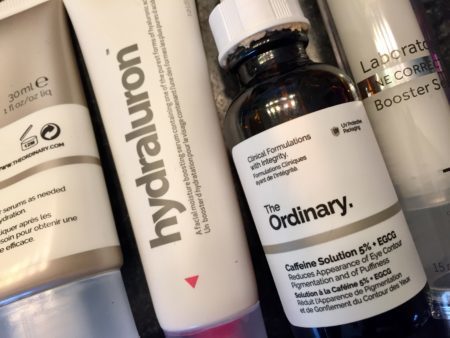 Sixty is more dry than juicy. It’s leave-in conditioner, moisturizer twice a day, hand cream in my purse, shea butter for cracking heels, and sunscreen even on cloudy days. (Better late than never.) Sixty is about lubricating. It’s receiving a birthday gift of four different face creams from a lifelong friend along with instructions to “layer.” It’s wrinkles and pouches and unwanted flaps of skin. Sixty is wrinkles. And it’s eternal hope, too. After all, four face creams!
Sixty is more dry than juicy. It’s leave-in conditioner, moisturizer twice a day, hand cream in my purse, shea butter for cracking heels, and sunscreen even on cloudy days. (Better late than never.) Sixty is about lubricating. It’s receiving a birthday gift of four different face creams from a lifelong friend along with instructions to “layer.” It’s wrinkles and pouches and unwanted flaps of skin. Sixty is wrinkles. And it’s eternal hope, too. After all, four face creams!
Sixty is no more hair growing in the places I used to shave and brand new hair cropping up in places it never was before. Sixty is keeping tweezers handy and letting the blade on the razor turn to rust. Sixty is a crepey neck and a permanently furrowed brow. It’s a new ability to spot a botoxed forehead from across the room. It’s realizing how many of us are smoothed out between the eyebrows. It’s looking crabby in every photograph, even when I’m happy. Which I am. Mostly.
Sixty has its moments of melancholy. So much is over. There’s no going back. Sixty is the realization that joy doesn’t just happen, I have to choose it again and again. It’s a choice that requires effort sometimes. Sixty is an opportunity to rethink some old ideas. It’s a farewell to a certain kind of ambition and it’s an uncomplicated pleasure in the job at hand – cutting back the garden, stuffing envelopes for a local nonprofit, driving a friend to the doctor, writing a good-enough paragraph. Sixty is time to let go of perfection. Time, also, to give up comparing, worrying, arguing over petty things, and taking slights personally. Sixty means there’s no more time to waste. (Not that there ever was.)
Sixty comes with permission to love my friends more deeply. It’s making the phone call, writing the note, coming up with the plan, making it happen. It’s texting a photo of the sunrise or the salad I made for dinner and getting a sunrise or a pie or a basket of swiss chard in return. It’s not hesitating to say whatever words I need to say: I’m sorry. Please forgive me. Thank you. I forgive you. I love you. It’s finding the perfect extravagant gift and it’s the joy of giving something wonderful to someone who doesn’t expect it.
Sixty is about accepting my limitations. It’s realizing I can’t be all things to all people. It’s speaking the truth and living with the consequences. Sixty is choosing integrity over popularity, which means watching some people walk away and being ok with that. And it’s befriending my own imperfect, less driven, less busy self. A self not so adept at retaining facts but somewhat better at taking the long view. A self who is done with multi-tasking but who turns out to be happier doing one thing at a time slowly and carefully and well. A self who is slower to hurt and anger and quicker to apologize. Less of a grind, but more at ease in her own skin. Less polished and more vulnerable. Less impressive but more honest. Kinder. Or so I hope.
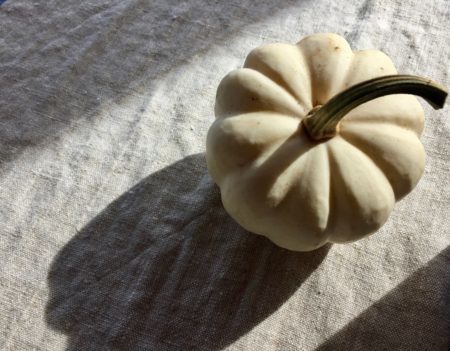 Sixty is an impulse to simplify. It’s looking around and noticing how much of what I have, I’ve ceased to really see. It’s packing stuff away, giving stuff away, throwing stuff away and exhaling into the empty spaces left behind. It’s more trips to Goodwill than to the mall. It’s wondering why I ever thought it was a good idea to collect anything. It’s a box in the basement slowly filling with things that once seemed like reflections of me but are now just things. It’s realizing they were always just things. Sixty is less time spent taking care of things and more time attending to what is ineffable, invisible, intangible. It’s forgiving everyone for everything and traveling a bit more lightly through my own emotional landscape. Sixty is about clearing some space – in a kitchen drawer, in my mind, in my relationships, in my heart.
Sixty is an impulse to simplify. It’s looking around and noticing how much of what I have, I’ve ceased to really see. It’s packing stuff away, giving stuff away, throwing stuff away and exhaling into the empty spaces left behind. It’s more trips to Goodwill than to the mall. It’s wondering why I ever thought it was a good idea to collect anything. It’s a box in the basement slowly filling with things that once seemed like reflections of me but are now just things. It’s realizing they were always just things. Sixty is less time spent taking care of things and more time attending to what is ineffable, invisible, intangible. It’s forgiving everyone for everything and traveling a bit more lightly through my own emotional landscape. Sixty is about clearing some space – in a kitchen drawer, in my mind, in my relationships, in my heart.
Sixty is a bit devil-may-care. It’s doing things because I want to rather than because someone else thinks I should. It’s saying no to what doesn’t feel right and yes to the small voice inside that says, “This way.” Sixty is planning a hiking trip to England with a bunch of women and volunteering to teach yoga to women in recovery. It’s discovering that we are more alike than different.
Sixty is a deepening concern for our shared future. It’s a desire to give something back, to make the world a little better while I still can. Sixty is flexible. It’s understanding that information isn’t wisdom, and that wisdom arrives quietly and in its own time, nourished by listening and silence and reflection. Sixty is a greater willingness to compromise, to collaborate, to consider another point of view. Sixty is less about being right and more about being present.
Sixty is daily gratitude for modern medicine and replacement parts. It’s two artificial hips and two four-inch scars and long, pain-free walks. It’s taking nothing for granted: climbing a mountain, carrying groceries, running upstairs, pushing a wheelbarrow, warrior pose. Sixty is still a two-way street, up and down, breaking apart and coming back together again. Sixty is self-care and maintenance. Sixty is strong and able. Sixty is fully alive, awake, and vital. Sixty is also knowing, in the words of the late poet Jane Kenyon, “Someday it will be otherwise.”
Sixty inspires a certain kind of urgency. It is a desire for a life that is both less and more. It’s the end of carrying on as if time were an unlimited resource to be spent and spent and spent. There is no world but this one. No meaning but the meaning I’m willing to create. I have one life and one life only. Though brief, it will have to do. Sixty feels like a nudge in the direction I’ve always wanted to go, a summons to pay closer attention to the way I spend my days, to the things I say and do, to the qualities I still aspire to embody.
Sixty is an invitation to make a deeper kind of peace with impermanence. It’s about rising to the challenges of aging and also embracing the mysteries, wonders, and gifts of growing older. It’s a desire to ripen into wisdom, into goodness, into a woman who may one day be an elder but who is, for now, just another year older. Sixty is knowing today is an occasion, tomorrow isn’t guaranteed, and every plan is provisional. Sixty is the beginning of the if-not-now-when decade.
Burn the candle.
Use the china.
Open the wine.
Carpe Omnia.
Seize everything.
The post this is 60 appeared first on Katrina Kenison.
September 21, 2018
why I believe her
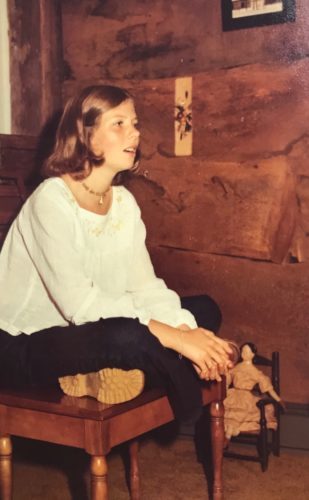 I suspect I’m not the only woman who finds herself thinking about truth and sex and high school this week. As supporters of Judge Brett Kavanaugh mount their crusade against Christine Blasey Ford, many of us are wondering what we would do in her shoes.
I suspect I’m not the only woman who finds herself thinking about truth and sex and high school this week. As supporters of Judge Brett Kavanaugh mount their crusade against Christine Blasey Ford, many of us are wondering what we would do in her shoes.
If it were me, could I endure the pressure and continue to stand my ground for the sake of the integrity of the Supreme Court? Would I have the courage to show up on a national stage and speak the truth, despite the massive attempts on the right to undermine me? Sitting alone in the safety of my own quiet home, my heart goes out to this deeply private woman who made the brave choice of stepping forward, only to be forced into hiding by death threats. I honestly have no idea whether I could put myself through the hostile process that will surely unfold next week if Dr. Ford decides to testify under oath even in the absence of the FBI investigation she has rightfully requested. But there’s one thing I do know: I absolutely believe she is telling the truth.
In the photo above, I am fifteen or sixteen, close to the age Dr. Ford was when she was assaulted in a locked room by a drunk older boy while his buddy first urged him on and then warned him to stop. This picture brings back all sorts of memories – of the kitchen in my house where it was taken, of the time it spent to blow dry my hair into that careful pageboy, of the shark-tooth choker I’m wearing around my neck. I remember the shirt, too – it was my “going out” blouse, an ivory smock I thought was soft and pretty and a bit bohemian. As soon as I came across the photo, I remembered another thing about that top: I always wore it with a leotard underneath. In those pre-camisole days, a leotard meant you had to get completely undressed to go to the bathroom. But a leotard under a loose blouse was also a necessary, albeit thin, line of defense against an unwanted male hand grabbing at your breasts.
As I approach sixty, I realize how much of the past I’ve forgotten over the years – the little things, the passing moments, the sweet ordinary memories that add up to a good, decent life.
But there are also incidents that remain indelible, even now. And many of those moments have to do with early sexual experiences, both good and bad. My own most intimate memories from high school and college are especially, sometimes painfully, vivid. The more disturbing ones are irrevocably lodged in my body, in my mind, and sometimes, still, in my dreams.
Coming of age, coming into our own as women, coming into our sexuality, navigating our way through our own first, fumbling sexual encounters — whether we initiate them, welcome them, or survive them; whether they are exhilarating or terrifying — this is big stuff.
You’d think it would go without saying.
And yet, today I feel the need today to say it: When it comes to sex, women don’t forget what we did or who we did it with, no matter how many years have passed. We most certainly remember, with precise and painful clarity, what was done to us. And we remember who did it.
This, apparently, is news to the men who now claim Christine Blasey Ford must be suffering from some kind of confusion or amnesia about exactly who assaulted her. How else to explain their latest line of defense of Brett Kavanaugh?
That seventeen-year-old kid who clamped a hand over fifteen year-old Christine’s Blasey’s mouth to keep her from screaming while he tried to rape her? That guy couldn’t have been our Supreme Court nominee! It must have been some other guy. Poor, confused Dr. Ford just doesn’t remember who.
Forty-two years after graduating from high school, I can still name the gropers. I remember exactly who they were. I remember what they looked like. I remember exactly what they did. I remember how ashamed and humiliated they made me feel. I remember keeping quiet, because to speak about these unspeakable things would somehow mean acknowledging the truth of them, and that would have been sickening and terrifying. And, while I did not find myself trapped in a room with a potential rapist at age fifteen, it requires no great leap of imagination on my part to envision the horror of such an assault or its after effects: a lifetime of nightmarish remembering, coping, healing.
This kind of pain doesn’t fade and get blurry around the edges over time. The face of one’s attacker doesn’t gradually morph into some other vaguely familiar face from the past. No. Just ask any survivor: the memory is the thing lasts. A woman who has been physically attacked by a man does not forget the experience, she relives it. Over time, if she’s lucky, she finds a way to move forward, albeit haunted by the ever-present, sharp-edged awareness of what was done to her. She lives while also knowing that the very person who inflicted that harm has rewritten the story so that he can live with himself: as if innocent, as if blameless, as if it never happened at all.
The men (and they are, for the most part, men) who are mounting a defense of Brett Kavanaugh on the basis of “mistaken identity” may look back on their own sexual exploits as a series of successful conquests or humiliating failures in which their consensual partners or unwilling victims were indistinguishable from one another and therefore forgettable.
It’s an appalling thought. But it seems that’s really how it was for these guys. They would have us believe that their youthful “escapades” meant little then and less now. To them, we were randomly appealing teenaged bodies to be lured in, pinned down, used and walked away from, with nary a backward glance.
Apparently that’s the way the Republicans on the judiciary committee still see things. How else could they so glibly justify Kavanaugh’s questionable past and, at the same time, work so vehemently to erode Dr. Ford’s credibility? Why else would they adamantly refuse to step on the brakes and call for an investigation that could either clear Judge Kavanaugh’s name or shed objective light on the facts as Dr. Ford remembers them? And how else could they expect anyone to buy this ridiculous line of defense?
And yet here we are, being told to shut up and swallow it as Brett Kavanaugh’s champions race him toward confirmation. It’s quite a disturbing glimpse into the inner workings of the mind of a certain kind of man. A man who experiences sex as being disconnected from feelings. A man who sees sex as his right. A man for whom sex is something to be done, denied, forgotten. A man much like the one in the White House.
further . . .
After a summer away from this space, I did not intend to resume writing with a post about politics. In fact, my intent was to share some reflections about reconnecting with my beloved first grade teacher. That story will wait. This one couldn’t. I felt moved to gather my own thoughts after listening to Atlantic writer Caitlin Flanagan recall being assaulted by a high school classmate, and the effect of that single traumatic incident. You can listen to her interview on the New York Times Daily here.
Dr. Ford’s credibility is supported by this NYT article by a psychiatrist who explains the neuroscience behind memories formed under the influence of intense emotion.
Michele Goldberg’s voice on the NYT opinion pages always makes me feel smarter and less alone. Read why she hopes Dr. Ford will testify next week here.
Twenty-seven years ago, Anna Quindlen wrote this piece about the Anita Hill hearings. She just reposted it on Facebook, acknowledging how dispiriting it is to realize that she could have as easily written it yesterday. As Anna pointed out then, and as so many of us agree now: “It is difficult to feel polite watching the white men of the United States Senate and realizing that their first response when confronted with a serious allegation of sexual harassment against a man nominated to the high court was to rush to judgment. It is difficult to feel polite, knowing they were more concerned about how this looked for them, for their party, their procedures and their political prospects than in discovering what really happened.” Yes.
The post why I believe her appeared first on Katrina Kenison.
June 12, 2018
kindness
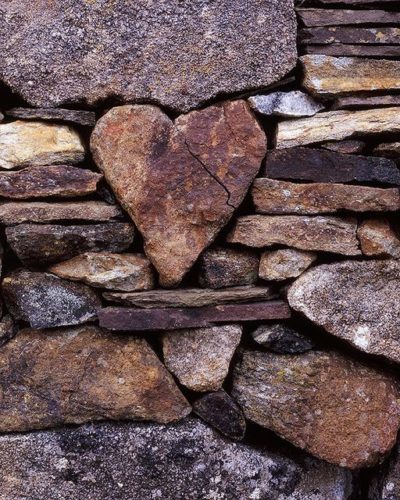 “The simplest acts of kindness are far more powerful
“The simplest acts of kindness are far more powerful
than a thousand heads bowing in prayer.” ~ Mahatma Gandhi
The other night at dinner I sat next to a dear friend I rarely get to see. For his 60th birthday, Randy and his husband had taken over a small restaurant they love and were hosting a beautiful meal for about two dozen people. “No gifts,” the invitation had said, “just dinner with good friends.” The setting was elegant and intimate, one long table set with candles and flowers, dusk falling, wine glasses being filled as each guest was warmly welcomed, introduced, and drawn into conversation.
In the moments before dessert was served, I asked my friend about his hopes and dreams for his sixties. I expected he’d return to a theme common in our conversations over the years – his impossible work-life balance – and that turning sixty might be prompting him to spend fewer hours at the office and more in his garden. I wouldn’t have been at all surprised if he’d expressed a desire to slow down, to read more books, take more bike rides, travel to new places, or just to spend more time with his partner of thirty years.
Instead, he answered my question with a word, one he’d clearly given some thought to already. “Kindness,” he said. “I’d just like to be more kind.”
My friend is one of the most intuitive, compassionate human beings I know. A psychiatrist with a private practice, he’s also the medical director at a large detox facility and an expert in addiction and recovery. In addition, he’s served as the therapist at a number of local boarding schools and, for many years, spent a couple days a week working with veterans at a nearby VA hospital. He’s devoted his career to being with people who are struggling, lost, in pain, listening not only with his mind but also with his heart. Kindness, it seems to me, is the quality that unites and informs everything he does.
And yet, when he envisions the years ahead, it is not more experiences or more achievements or more things or even more time my friend wishes to create space for, but more kindness. I looked around at the faces of those gathered at the table, everyone enjoying their dinner, the good company, the invisible yet precious gift of belonging and of feeling cherished, and realized my friend’s quiet kindness campaign had already begun.
In the days since Kate Spade and Anthony Bourdain took their lives, I’ve found myself engaged in a number of conversations about despair. There is the anguish of the world at large, ever present, delivered to us daily in whatever dose we deem bearable. There is a president whose assaults on truth, democracy, and human dignity are not only horrifying to many but life-threatening. There are, always, heart-wrenching losses close to home – a friend’s son’s sudden death, another’s diagnosis, a loved one’s lost job. There’s the general level of rudeness and pettiness woven through the fabric of our own everyday doings – and the challenge of how to respond in the moment to the blaring horn at a stoplight, the flipped finger, the casually tossed F-bomb, the hate-filled bumper sticker, the town clerk who frowns and turns her back rather than extending her office hours for five more minutes. There is the dizzying sense of changing norms, the realization that cruel, inhumane language and behavior that would not have been tolerated in the recent past is now considered acceptable and is sometimes even applauded.
And then there is the unfathomable mystery of what it is to be a hurting human being engaged in a life-or-death battle with depression, shame, misery, and suicidal impulses. We wonder how lives that looked so very splendid from the outside could have felt utterly unbearable on the inside. And we think of those among us who are wrestling with their own private demons but who may also be isolated, broke, weary, without any financial security or social connections, let alone fame, fortune, and adoring fans to brighten the darkness. If the Kate Spades and the Anthony Bourdains of the world can’t go on, we might well ask, what hope is there for any normal person who’s feeling desperate and alone?
As I think about the people I love whose lives are shadowed by depression, anxiety, addiction, illness, or grief, I can’t help but wonder about all the others whose daily struggles are invisible to me. Surely I walk among them, oblivious. Surely I, and we as a culture, have a great deal of work to do. Shocking as these two very public suicides have been, they also serve as a reminder that too many others are suffering in anonymous silence. The stigmas of loneliness, need, and mental illness create dangerous, destructive barriers between us. A country in which 45,000 people a year commit suicide is a country that is deeply troubled.
Meanwhile, as a nation, we seem to be losing something essential and ineffable – our belief in basic decency as a part of the social contract. As Andrew Solomon observes in his necessary, profoundly wise essay about suffering and the preventable tragedy of suicide in the June 8 issue of The New Yorker:
On a national stage, we’ve seen an embrace of prejudice and intolerance, and that affects the mood of all citizens. My psychoanalyst said that he had never before had every one of his patients discuss national politics repeatedly, in session after session. Now there is a continuous strain of anxiety and fear from one side, and brutality from the other. Hatred is depressing—it is of course depressing to be hated, but it is also depressing to hate. The erosion of the social safety net means that more and more people are at a sudden breaking point, and there are few messages of authentic comfort to offer them in these pitiless times. One is done in by disease, by isolation and despair, and by life crisis. At the moment, many people’s vulnerability is exacerbated by the unkindness manifest in each day’s headlines. We feel both our own anguish and the world’s. There is a dearth of empathy, even of kindness, in the national conversation, and those deficits turn ordinary neurosis into actionable despair.”
Of course, coming upon these lines this morning, I thought right away of my friend’s birthday intention. I recall, too, something the Dalai Lama says quite often: “My religion is very simple. My religion is kindness.”
It does sound like such a simple thing, kindness. Almost too plain and obvious to warrant much reflection or discussion. And yet, these words give me not only hope but also a sense of direction after months of feeling a little lost. In so many ways, we are profoundly powerless. We cannot make pain and suffering disappear. We can’t control the hurtful actions of others or silence the voices that threaten, humiliate, insult, or shame. We cannot solve the opioid crisis, keep the desperate family together at the border, slow the arctic melt, or prevent the disturbed teenager from killing his classmates. But we can bring more kindness into the world. Sometimes, that is all we can do.
Kindness is about showing up, unbidden, and doing whatever there is to done. Kindness requires us to stretch in ways that may be uncomfortable, unfamiliar, risky, new. Kindness asks that we give of ourselves, generously, and without thought of reward or repayment. And yet there are invisible dividends for even the simplest good deed, be it a smile offered, a hand extended, or a word of support given. Any act of kindness fortifies our connection with the person we have touched. Kindness, as our spiritual teachers remind us, is our true nature, our own untrammelled, always-available route to an inner sense of well-being. Being kind may not make us successful or rich or heroic, but being kind does make us a little happier and someone else’s day a little better — and really, that’s saying something. Kindness is our gift to one another, to the world, and to our own best selves.
Kindness is my soul daughter Lauren taking a day off to drive four hours north to Asheville to visit my son Jack, stopping along the way to fill her car with groceries for him. “No one ever did that for me,” she explained, “but I always thought how nice it would be.”
Kindness is my husband and his sister flying to Florida together this week to accompany their widowed sister to the hospital for a hip replacement, and to cook and clean and care for her when she gets home.
Kindness is my friend Maude, who pauses repeatedly as we walk together to clear branches away from the path, to carry a small orange salamander to safety, to pick up a piece of trash by the roadside, to compliment an elderly stranger’s well-behaved dog.
Kindness is my son Henry offering to spend a week of his summer supporting and caring for a beloved professor who’s recovering from open-heart surgery.
Kindness is my dad who, when he finishes mowing his own lawn, goes ahead and mows his neighbors’ lawns as well. It’s my mom, saying, “Stop in for dinner here,” when we’re driving home from the airport.
Kindness is my neighbor Debbie, tucking yellow foxgloves into my garden to replace the ones that didn’t survive the winter.
Kindness is my friend Ann stuffing her pockets with one-dollar bills every time she goes to New York City, and then stopping to greet each street person she encounters with a smile and a friendly word. It is my friend Margaret, who built a website for the young flower farmers in her town, and then joined forces with a local shopkeeper to help them create a shop of their own. It is my friend Tracy, who invites everyone she knows to send a Valentine to her grandmother in a nursing home in California. It is the hundreds of people who read her Facebook post, buy a pretty card, and write a note to an elderly woman they do not know.
Kindness has a way of replicating itself, rippling outward, gathering energy as it goes, setting more and more kindness in motion, bringing a bit more peace and goodness into the world.
I know all this already. And yet, even so, there’s quite a difference between being nice when it suits me and actually dedicating myself to kindness. Henry James knew it, too. Which is no doubt why he took pains to make his own priorities so clear: “Three things in human life are important: The first is to be kind; the second is to be kind; and the third is to be kind.”
It’s so tempting at times to respond to all that’s wrong in the world by allowing our hearts to harden, our kindness to atrophy, and our expectations of ourselves and others to shrink. But I’d rather go the other way. I want my heart to remain open, to soften, to grow. When I feel most vulnerable, I want to reach out and gently touch someone else’s tender place. When fear or sadness threaten to overtake me, I want to remember that kindness is a way forward. And when anger flares, I want to respond not with reactivity and defensiveness, but with patience and compassion.
In four months, I’ll turn sixty, too. Time, it turns out, is finite. And the truth of what really matters comes into sharper focus by the day. Watching the Marjory Stoneman Douglas High School drama students performing “Seasons of Love” at Sunday night’s Tony Awards, I was surprised by the tears streaming down my face, only to realize that nearly everyone in the audience was weeping, too. I suspect our tears were as much about hope for our shared future as they were about sadness for the senseless tragedy that claimed the lives of these kids’ friends. In the face of unspeakable loss and senseless violence, these brave young people are choosing kindness and love, passion and presence, as their path toward healing. We can take a cue from them.
I wonder how my life might change if I were to commit myself anew each morning to just one simple thing: cultivating a kinder heart. How would the world change if each of us did the same? Could it be that the only appropriate, indeed the only humane, response to actionable despair is actionable kindness? And could it also be that our last, best hope for saving ourselves and our planet is to make kindness our religion, too, a religion that recognizes and confirms our inextricable interconnectedness, and that rejects any leader or dogma or doctrine that makes any human being feel separate, unsafe, or unworthy?
Suddenly, my own bucket list has become pretty short. Be kind. Be kind. Be kind.
The post kindness appeared first on Katrina Kenison.
April 12, 2018
you are enough
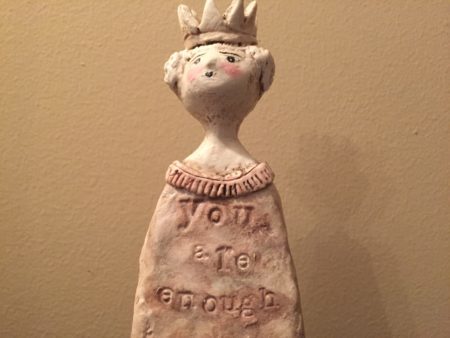 “Sit down wherever you are
“Sit down wherever you are
And listen to the wind singing in your veins.” ~ John Welwood
You are enough.
Is it fair to say that taking these three simple words to heart is one of life’s great challenges?
Lately, they’ve been giving me pause.
I’m near the end of a seven-month yoga training that’s tested me in ways I didn’t foresee when I signed on. Our small group of women meets for one long, intense weekend a month at the studio here in our town. Some are working toward becoming certified instructors. Others, like me, enrolled because it was a local opportunity to deepen our practice, to refresh our skills, and to read and study the philosophy of yoga and meditation with an inspiring teacher and some like-minded souls.
Early on, I realized that a large part of my own journey in this course would be about making peace with limitations. Two years after having both hips replaced, I’m able to walk and stretch and sit cross-legged without pain. In yoga class, though, I confront the edge of what’s possible. While my ego says, “Try harder, go deeper, be better,” my bionic joints offer a different message: “Be ok with where you are, breathe here, don’t push it.”
I can put myself into a deep lunge or forward fold, but the creepy popping sound of two artificial hips subluxating part way out of their sockets is a compelling reminder that no good can come of it. And so, I use blocks placed on the high end. I move slowly and with care. I practice transforming my desire for something more into gratitude for what is. The real challenge isn’t about lowering my thigh or my hands to the floor. It’s about finding a new way to work with that word enough.
But the inner dialogue doesn’t end with lunges and bends. Assigned a lengthy list of muscles and tendons to understand and memorize, I was surprised to observe how these unfamiliar words run through my brain like water through a sieve. I can read and comprehend just about anything that’s in front of me. Take the printed page away, though, and ask me to recite any of it back, and there’s a kind of foggy sky where there was once a solid mental blackboard full of whatever I was supposed to know.
I don’t really think my mind is going, but it’s changing. Seven years ago when I did my own teacher training, I made flash cards and memorized the Sanskrit names of all the poses, the bodily systems, the basic anatomical terms. I don’t have to do all that again, thankfully. But could I, if I had to? I’m not so sure. Do I actually know enough to teach anyone anything? Can my mind be less than it once was and still be enough? And if I’m less capable in some areas, can I still be enough in others? Does being enough as I grow older include continually surrendering to diminishment, narrowing possibilities, and loss?
My deep sadness this winter at the sudden death of a life-long friend has been complicated by regret for not having been a better friend myself. I’ve lost count of how many times I’ve re-read our last email exchange, from the end of January, wondering how I could have failed to read between the lines, failed to realize how sick she was, failed to let her know how much she meant to me. I wrote her back, urging her to take care of herself. But I didn’t call. I didn’t jump on a plane to Santa Fe. I didn’t even write again the next day, or the next, to check in. And then she was gone.
“She always loved you best,” a mutual friend said recently. “You were an anchor for her,” said another. And also: “She spoke of you often.” “Your name always came up.” “What you two had was special.” All of these kind words, intended to console, only make me feel worse. I should have been there. I wasn’t.
You are enough? Oh no, I’m not. Not always. Sometimes it’s just so hard to live with our own damned humanness.
In recent days I’ve inadvertently offended a cherished friend, left a forgotten load of laundry to solidify into a wrinkled mass in the dryer, failed to read the book club book, and procrastinated once again on cleaning the basement, which I meant to do in January. I haven’t exercised or meditated or written anything (till now). I ate two entire crème brulees in one sitting. At night I lie awake beside my sleeping husband, restless, thinking about all the things I’d do differently if I could.
But. I have also been forgiven, with grace and kindness, by my friend. I’ve driven a neighbor to Boston and back for a doctors’ appointment, made a special dinner for my parents, written notes to loved ones, gone on a date with my husband, and had long heartfelt phone conversations with my kids. I can still iron those shirts. I can show up for book group and trust I’ll be welcomed anyway. I can take a walk, or sit in silence for twenty minutes, or make a first pass at the basement. Those crème brulees didn’t kill me or even matter in the grand scheme of things. Whatever I do, or fail to do, life goes on.
Before I flew to Nashville last month to interview Anna Quindlen, I prepared like the diligent English major I once was – as if I were going forth to teach a graduate seminar rather than to have an hour-long chat with her. I read (or re-read) the backlist, highlighter in hand, watched every interview she’s ever done, and filled about a hundred file cards with notes and questions, knowing all the while that when the time came I’d have to step out onto the stage without any of those crib sheets in my hand. (That brain-like-a-sieve thing had me worried, though, and I figured the more homework I did in advance, the more at ease I’d be in the moment.)
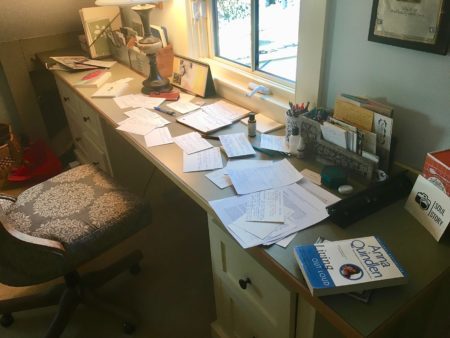 As it turned out, our conversation flowed readily. Small in size but large in stature, Anna is as warm and kind and funny in life as she is on the page. A kind of Rock Star/Normal Person, she is quite a commanding presence, completely self-assured yet also approachable. This, I sensed right away, is what “enough” looks like — a woman who is at home in her own skin and at home in the world.
As it turned out, our conversation flowed readily. Small in size but large in stature, Anna is as warm and kind and funny in life as she is on the page. A kind of Rock Star/Normal Person, she is quite a commanding presence, completely self-assured yet also approachable. This, I sensed right away, is what “enough” looks like — a woman who is at home in her own skin and at home in the world.
And for that hour in front of the audience, I was “enough,” too. All those weeks spent reading and thinking and writing weren’t wasted. They’d made it possible for me, the quiet introvert from small-town New Hampshire, to be wired up with a microphone and engage in a lively, spontaneous chat with the Pulitzer Prize-winning, best-selling novelist from Manhattan. Sometimes, for me, being enough means putting in the extra time and effort required to bring my very best self to the table.
At one point toward the end of our talk, I observed that Anna is, among so many other things, the queen of the commencement address. She’s given dozens of them over the years, full of candor, insight, and encouragement for those setting forth into their young adult lives. Reading through those speeches was enough to make me a bit envious of the thousands of students who’ve received her hard-won wisdom.
“I wish you could give a commencement speech to all of us who are entering our older adult lives,” I said. “Approaching sixty feels like its own right of passage, just with different questions and uncertainties. What do you have to say to those of us who are graduating out of middle age?”
Anna didn’t hesitate. “At a certain point in my fifties,” she said, “I woke up one morning and decided I was just done. I was done listening to all the negative voices in my head. The voices that said, ‘You’re not pretty enough, or smart enough, or nice enough, or thin enough, or good enough.’ I realized that I am who I am — and I’m fine with that. I’m enough. And having that clear sense of myself, and that acceptance, completely freed me. I suddenly had a lot more time and energy to put into the things that matter. Like living my life and doing my work.
“The women I know in their sixties,” she went on, “they all rock. They’re doing exactly what they want to do, and they are enjoying life to the fullest, because they aren’t wasting any more precious time doubting themselves or doubting their worth.”
This insight was the real take-away, the gift of the few hours I spent hanging out with Anna Quindlen, both onstage and over a late dinner with Ann Patchett and my soul daughter Lauren: Life is a lot more interesting once we finally get over ourselves.
We can go on rehashing our familiar litanies of regrets, mistakes, and self-doubts. Or, we can put the tired old stories away, step into our own power, and have a fresh look around – for a way to be helpful right here and for something to be grateful for right now. And guess what? The whole world glows a little brighter as soon as we lighten up and turn our gazes outward.
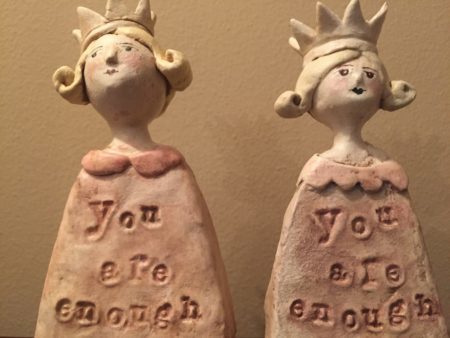 Being “enough,” it turns out, is a choice not an accomplishment. Being enough has nothing to do with our achievements and everything to do with our qualities. And so the conversation I want to have with myself these days isn’t “Am I enough?” but rather, “Am I being kind? Am I being honest? Am I being useful? Have I made the day a little easier or a little better for someone else?”
Being “enough,” it turns out, is a choice not an accomplishment. Being enough has nothing to do with our achievements and everything to do with our qualities. And so the conversation I want to have with myself these days isn’t “Am I enough?” but rather, “Am I being kind? Am I being honest? Am I being useful? Have I made the day a little easier or a little better for someone else?”
In a way, this intention lets me off the hook for all the things beyond my control – the wrinkles and forgetfulness and creaky joints; being shy and solitary by nature; feeling sad or anxious or less than confident. And it allows for my mistakes and failures, too, because being enough in no way means being perfect. It means both forgiving myself and making my own ordinary life be about something bigger than me. It means starting where I am with what I have: this body, this temperament, this day, this task of being alive in the world — a world much in need of all the care and compassion and healing each one of us has to offer.
As so often happens when I (finally) do sit down at my desk, the universe provides a whisper of encouragement. Today it was the poem below, which appeared this week on the always wonderful and often magically serendipitous site First Sip. The lovely “You Are Enough” ladies are the paper-mache work of Nova Scotia artist Jane Creelman, an early Mother’s Day gift from Lauren which touched my heart and helped inspire these reflections. You can follow Jane on Instagram here. Finally, congratulations to reader Reena Roshgadol, who won the signed copy of Anna Quindlen’s Alternate Side. If you didn’t win, I hope you’ll treat yourself to this provocative novel in any case, and also to my all-time favorite book of Anna’s, Lots of Candles, Plenty of Cake. It’s the one I return to every time I need a dose of confidence, courage, or compassion. (Just click on the titles to order via my affiliate link on Amazon.)
Sit down wherever you are
And listen to the wind singing in your veins.
Feel the love, the longing, the fear in your bones.
Open your heart to who you are, right now,
Not who you would like to be,
Not the saint you are striving to become,
But the being right here before you, inside you, around you.
All of you is holy.
You are already more and less
Than whatever you can know.
Breathe out,
Touch in,
Let go.
~ John Welwood
The post you are enough appeared first on Katrina Kenison.
March 22, 2018
a chat with Anna Quindlen
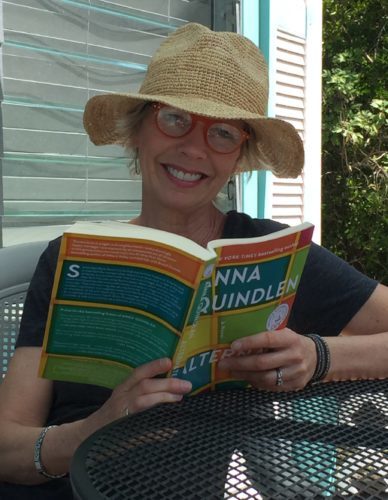 “Look around at the azaleas making fuchsia star bursts in spring; look at a full moon hanging silver in a black sky on a cold night. And realize that life is glorious, and that you have no business taking it for granted.” ~ Anna Quindlen
“Look around at the azaleas making fuchsia star bursts in spring; look at a full moon hanging silver in a black sky on a cold night. And realize that life is glorious, and that you have no business taking it for granted.” ~ Anna Quindlen
I have been having a lively conversation in my mind with author Anna Quindlen for about twenty-five years. She’s my wiser, more observant, funnier best friend — albeit, the one I’ve never actually met. Still, I’m pretty sure if we were neighbors we’d get together to walk our dogs every morning and compare notes on what’s going on in the world, what we’re making for dinner, what we’re reading and thinking and worrying about. (I’m also pretty sure every other Anna Quindlen fan feels exactly the same way I do. To read Anna Quindlen is to wish she lived next door.)
So when Ann Patchett asked if I’d like to come to Nashville to interview Anna about her new novel I leapt at the chance. At last! Our conversation would finally move out of my head and into real life.
Alternate Side sneaks up on you. It begins simply enough, with a middle-aged man’s acquisition of a permanent parking space in his affluent, tightly knit Manhattan neighborhood and his wife’s less than enthusiastic response to his good fortune. And from there it goes on to explore just about all the questions I lie awake pondering at two a.m. – everything from Is my family ok? to Is our country ever going to be ok again?
With great insight, tenderness, and humor Anna creates a portrait of a long-lived, seemingly happy marriage, and then she reveals the fissures beneath the surface. She draws us into a tranquil community of privileged people and introduces the dedicated, far less privileged men and women who make such lives possible. And then, pulling no punches, she reveals just how little we actually know of the people closest to us and how precarious even the most carefully constructed life really is.
Frankly, it was a little eerie, reading Alternate Side. Whether you live in Kansas or California, New Hampshire or New York, it’s the kind of book that asks you to stop and take a closer look at the divisions, tensions, and alternate sides of your own world. It may also make you feel as if the author is hanging out on your doorstep, reading your mind, eavesdropping on your phone calls, debriefing your kids, and listening in on the argument you just had with with your spouse at the breakfast table.
Perhaps, given our long relationship with Anna Quindlen – nine best-selling novels and eight works of memoir/nonfiction — this should come as no surprise to anyone. She knows us so well! She is us. (A critic once called her “the sanest person in America,” and it’s easy to see why.) Still, when a book hits this close to home, when it cracks your heart open and makes you rethink all of your assumptions, you can’t help but sit up and pay attention.
And when a novel comes along that’s as timely and as unsettling as Alternate Side, you also want everyone you know to read it – soon — so you can all get together and have a chat about it. It’s a page-turner. And once you turn that last page you’re going to want to have someone to talk to.
I wish you could all come to Nashville on March 28 to join me and Anna Quindlen for our conversation at the Nashville Public Library. (If you live nearby, do come! Ticket info for this free event is on the Parnassus Books site, here.)
But here’s the next best thing: I’ll come home with a signed book from Anna to give away here.
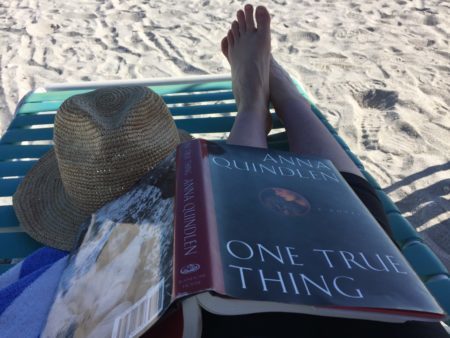 P.S. It just so happens that the arrival of Anna’s galley coincided with a brief family vacation in Florida, hence my goofy sun hat. But the truth is, Alternate Side should be the beach book of 2018 — and the book club novel of the year as well. With my appetite whetted for more, I went straight back to one of AQ’s earliest and best-loved novels, One True Thing, which is really one of the great classics of mother-daughter relationships. And if you want to know exactly why I feel such a kinship with Anna, treat yourself to her most recent collection of personal essays, Lots of Candles, Plenty of Cake. You’ll wish she lived next door to you, too.
P.S. It just so happens that the arrival of Anna’s galley coincided with a brief family vacation in Florida, hence my goofy sun hat. But the truth is, Alternate Side should be the beach book of 2018 — and the book club novel of the year as well. With my appetite whetted for more, I went straight back to one of AQ’s earliest and best-loved novels, One True Thing, which is really one of the great classics of mother-daughter relationships. And if you want to know exactly why I feel such a kinship with Anna, treat yourself to her most recent collection of personal essays, Lots of Candles, Plenty of Cake. You’ll wish she lived next door to you, too.
to enter to win a signed book
Just leave a comment below to enter to win a signed first edition of Alternate Side. Have a question you’d like me to ask Anna? By all means let me know. (She says nothing is off the table.) If you’re willing to share an “alternate sides” situation from your own life, I’d love to hear about it. Or you can simply say, Count me in. I’ll choose a winner at random after midnight on Thursday, April 5.
If you want to be sure of getting your own signed copy, you can pre-order one from Parnassus right here. (Or, order from Amazon here. This is an affiliate link.)
The post a chat with Anna Quindlen appeared first on Katrina Kenison.
March 3, 2018
on the death of a friend
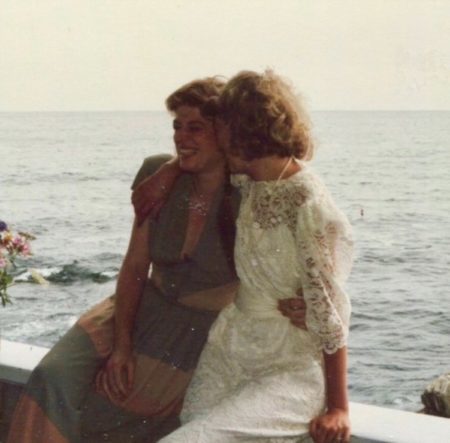 “I can only note that the past is beautiful because one never realizes an emotion at the time. It expands later, and thus we don’t have complete emotions about the present, only about the past.” Virginia Woolf
“I can only note that the past is beautiful because one never realizes an emotion at the time. It expands later, and thus we don’t have complete emotions about the present, only about the past.” Virginia Woolf
dinner
A few weeks ago, I met a friend I see a couple of times a year.
“So, how are you?” he asked, after we’d exchanged hugs and hellos and settled into our chairs. The restaurant was cozy and warm, lit by candles and strings of tiny white lights.
I paused before answering. “It won’t last,” I said. “But at the moment, apart from all the sadness and craziness in the world, everything in my own life is fine. The kids are doing well. All my friends are ok. And my husband and parents are healthy. Right now, there’s no one I love who I have to worry about.” I felt uneasy as soon as I said it, despite the verbal knock on wood. “Tell me about you,” I said to my friend, taking a sip of wine.
Valentines Day
My friend Maude and I went out for a walk. I’d spent the morning in the kitchen baking heart-shaped cookies, basking in silence rather than listening to a book or a podcast, as I often do while cooking. In a couple of hours, I’d make shrimp scampi for dinner, my husband would come home, we’d pour Prosecco, sit in front of the fire, exchange funny cards. And in between, on a February day that held a promise of spring in the air, there was an hour to spend catching up with a friend.
As we turned and headed back to our cars that afternoon, Maude’s phone vibrated in her pocket. She pulled it out to check the text and saw the headline first. “There’s been another school shooting,” she said quietly. “In Florida.” We stood there in the woods for a moment, uncertain. Should we stop in our tracks, phones in hand, and seek out the details of this latest tragedy, or should we continue our walk, our plans for the day, our own ordinary lives?
We walked on, subdued by the knowledge that somewhere far from our quiet country trail, a horrifying, all too familiar drama was once again unfolding. Back at home, fixing dinner, I left the TV off. And later that night, curled up on the sofa next to my husband as the fire died down, I found myself conflicted again.
How are we to live in these times?
words
As a person who writes in order to figure out what I think, I’ve always found order and comfort in the slow, halting explorations that bring words to the page. Writing is my way of making some sense of things. But not lately.
I have been trying to write my way through the wake of seventeen more innocent people dead, of the NRA digging in, of our government in shambles, a president who seems unhinged, human beings slaughtered in senseless wars, our planet under assault, the unfathomable threat of nuclear annihilation.
I have been trying to write about the shock and sadness of losing a friend who was larger than life and dearer to me than I can begin to express. But I can’t do it. The very noun “friend” – so generic and flat, so casually assigned — is inadequate. She was more than that.
Writing, like reading, is a way to awaken myself to truth, painful as it may be. Writing creates a pathway upon which my heart and mind can meet and come into alignment. Writing deepens my awareness, creates intimacy, clarifies my intentions. Writing, I knit myself back together. In the past I’ve turned to words to mend and heal what is broken, to inspire me and to teach me what I need to know. At the moment, my faith in words is shaky.
Each time I turn on the evening news I’m reminded: words are a double-edged sword. They have the power to inflame as well as to inform, to separate as well as to connect. Words destroy alliances, fuel anger, and spread propaganda, fear, and falsehood. Used cruelly, words shame and alienate and bully.
And in the throes of grief, words fail.
There is something to be said for silence.
note
“Pretend I can spell, pretend I know how to punctuate, and anything that really doesn’t make sense, let me know and I’ll sort it out.”
She’d been sick, she said, and dictating took less energy than typing. But the autocorrect on her phone had a mind if its own and had stopped responding. Hence the random, nonsensical words sprinkled through her previous email, which she was attempting, with only moderate success, to fix in the second.
I could figure out what she meant pretty easily. But, despite forty-two years of ongoing conversation, I completely missed the message.
Here’s what doesn’t make sense: These were her last words to me. Two weeks later, she was gone.
coffee
I’d never had a taste for coffee before I arrived at college in the fall of 1976. Tory, who had lived in Paris and gone to high school in Munich, was a connoisseur at eighteen. We drank hundreds of cups of coffee, sitting across from each other at tables all over campus, all over town. These were pre-Starbucks days, back when a cup of coffee in a small New England restaurant was just a cup of coffee. Even so, we had our ritual. Tory would fill her mug to within half an inch of the rim. She would add cream, slowly, deliberately, till it formed a trembling, frangible skin just slightly higher than the top of the cup itself. And then, waving her arm as she launched into some story or other, she would bump her mug, sloshing a wave of hot coffee across the table. She did it every time. Even on the refill. Tory always believed there was just a little more room in the cup. I learned early on to take extra napkins.
timing
When I turned fifty-nine last October, I began thinking about things I wish to do before my sixtieth birthday. My goal was to arrive at that milestone without regret. There were no bucket-list adventures on the list I started keeping in a black notebook. But I had ideas: to spend more time with my parents, with my husband, with our kids. To say “yes” more often. To have more fun. To stay in closer touch with my friends. I wrote down the names of people I most wanted to see.
“Perhaps I should visit you and your studio in Santa Fe before it’s too late?” I wrote to Tory in January.
I did not know then that the flu she’d had all fall was not the flu. Or that the parasite she thought she’d picked up in Australia was not a parasite. I did not know she would not be moving to a new home this summer as planned.
I did not know that it was already too late.
news
The morning after having dinner with my friend, I awoke early and reached for my laptop. The first thing I saw was an email from someone whose name I didn’t recognize, with a subject whose name I did.
You must not come to Santa Fe, Cynde insisted a few hours later, when we finally spoke by phone and I told her I’d get on the next plane. Her voice was kind, but firm. Tory was no longer speaking much, but she had made her final wishes known – for solitude, for privacy.
“She says she’s not scared,” Cynde said. “And she doesn’t want anyone to see her this way. Not even you.”
quotes
“Write out of love or anger.” ~ Patty Dann
“There comes a time when you realize that everything is a dream, and only those things preserved in writing have any possibility of being real.” ~ James Salter
“All sorrows can be borne if you put them in a story or tell a story about them.” ~ Isak Dinesen
intention
I will try.
The post on the death of a friend appeared first on Katrina Kenison.
January 29, 2018
tell me morea perfect February read
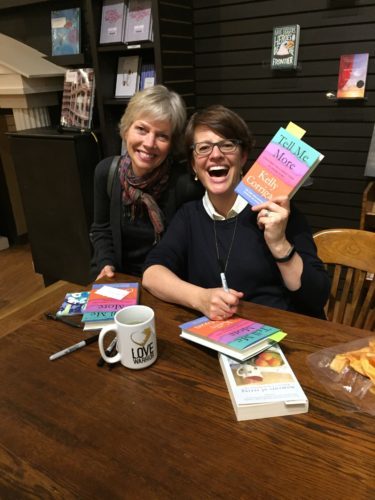 “Lives don’t last; they thrill and confound and circle and overflow and disappear because it’s like this, having a life.” ~ Kelly Corrigan
“Lives don’t last; they thrill and confound and circle and overflow and disappear because it’s like this, having a life.” ~ Kelly Corrigan
The Huffington Post has called Kelly Corrigan “the poet laureate of the ordinary.”
Damn, I thought when I first read that. I sort of wanted it to be me. Could there be any higher praise? But I’ll also be the first to admit: she deserves every bit of that acclaim. I’ve loved each of Kelly’s books, in part because of her rare, yet almost offhand ability to create what feels like instantaneous, genuine intimacy between herself and the rest of us.
To open any Kelly Corrigan book is to think, “If we two could meet, we would definitely be friends.” Although she and I had never actually laid eyes on each other until last week, I’ve had to keep reminding myself of that. More powerful than the truth is the feeling I’ve known her for years, ever since all our kids were young; or, rather, ever since I read The Middle Place.
My guess is that if you’re already a Kelly fan, you know exactly what I’m talking about. If you’re not, no worries, you can start right here. Reading her heartfelt, self-deprecating, generous memoirs, one can’t help but feel both seen and validated, welcomed into what appears to be a charmed inner circle — a safe place in which female friendships are treasured, the ups and downs of marriage and family life are survived with good humor if not always grace, and the messy, unfathomable rewards and challenges of motherhood are honestly, often hilariously, chronicled and given their due.
But this circle is also a place where awful things happen, where decent people screw up, where teenagers behave badly, and where dearly beloved ones die too soon. Because of course there is no such thing as a charmed life, only charmed moments – fleeting, precious moments that are all too often missed while our flighty, petty, over-burdened minds are occupied elsewhere. And Kelly Corrigan’s subject isn’t some made-up, idealized life but her own imperfect real one, with all its pain and beauty, heartache and redemption, loss and love, hairballs and eggshells and toenail clippings, tender deathbed confessions and unexpected epiphanies. She writes, to quote mindfulness teacher Jon Kabat-Zinn, about “the whole human catastrophe.” And in the process, she assures us that our own catastrophe is worthy of notice, embrace, and celebration.
Tell Me More made me laugh out loud in public and it made me cry unexpected, gulpy tears, in equal measure. To call it a self-help book would be to give it short shrift as the tender, often eloquent work of story-telling, personal exploration, and universal discovery it actually is. And yet, help it most certainly does. In the days since I first read it, I’ve found myself putting just about all of these twelve familiar phrases into practice in a whole new way: intentionally, lovingly, gratefully.
What are the hardest things we have to say to each other? How can we be open-hearted listeners? How can we find the right words to convey all that we feel and all that we know and all that we wonder about and all that we can never hope to understand? How do we talk about fear and regret? How do we summon the sentence that might open a heart, or ease a conscience, or erase a doubt? These are the questions at the heart of Tell Me More, a wise and deeply practical – even useful – memoir/manual for all of us who simply want to do a better job at being our better selves.
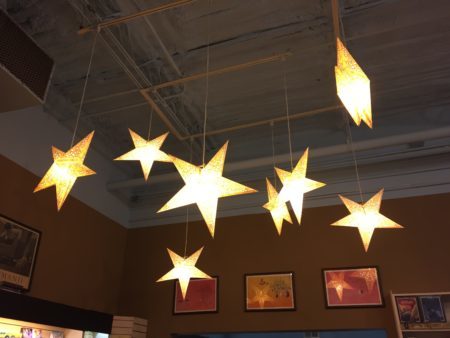 When I first heard there was a new Kelly Corrigan book coming out this winter, I went straight to my laptop to Google her tour schedule. While some might dream of a January escape involving drinks at sunset on a beach somewhere, my own antidote to the winter doldrums came together as soon as I saw that Kelly was going to read at Parnassus, my friend Ann Patchett’s bookstore in Nashville.
When I first heard there was a new Kelly Corrigan book coming out this winter, I went straight to my laptop to Google her tour schedule. While some might dream of a January escape involving drinks at sunset on a beach somewhere, my own antidote to the winter doldrums came together as soon as I saw that Kelly was going to read at Parnassus, my friend Ann Patchett’s bookstore in Nashville.
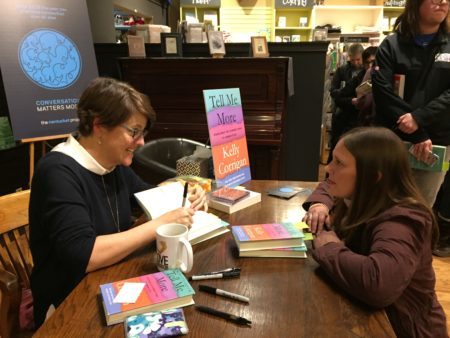 Destination decided! My soul daughter Lauren, just a three-hour drive away in Atlanta was game to come, as was my mom, who loved the idea of a road trip with us. And so it was that three generations of my family, blood mother and chosen daughter, were in the audience at Parnassus last Tuesday night. We had the joy of meeting Kelly in person and of hearing her talk about how, out of her grief at losing her dad and her best friend, came a deep desire to grow, to change, and to transform that sadness into even deeper awareness, simpler love, greater understanding, gratitude.
Destination decided! My soul daughter Lauren, just a three-hour drive away in Atlanta was game to come, as was my mom, who loved the idea of a road trip with us. And so it was that three generations of my family, blood mother and chosen daughter, were in the audience at Parnassus last Tuesday night. We had the joy of meeting Kelly in person and of hearing her talk about how, out of her grief at losing her dad and her best friend, came a deep desire to grow, to change, and to transform that sadness into even deeper awareness, simpler love, greater understanding, gratitude.
Of course, I could write a whole piece here about how much fun my mom and Lauren and I had romping around in Nashville for a couple of days (oh, the Patsy Cline Museum!!), but I’d rather get right to the point, which is this:
I have a signed first edition of Tell Me More from Parnassus to share with one lucky reader. Details below.
It’s not often that I say, “Just get this book,” but I’m saying it now. Whether you win a signed copy from me, or attend a reading yourself (Kelly’s tour schedule is here), or head down to your local bookstore, do treat yourself to Tell Me More. In its own humble, unpretentious way, this one is a life changer. It’s already shifted the way I’m talking with my own two grown sons. It’s making me think more deeply about everything I say and everything I do. And I find myself wanting to press copies into the hands of all my own nearest and dearest, just because. And to remind them, as Kelly Corrigan has reminded me:
This abstract performance art called Family Life is our one run at the ultimate improv. Our chance to be great for someone, to give another person enough of what they need to be happy. Ours to overlook or lose track of or bemoan, ours to recommit to, to apologize for, to try again for. Ours to watch disappear into their next self – toddler to tyke, tween to teen – ours to drop off somewhere and miss forever. It’s happening right now, whether we attend to it or not.”
It is said that the best books grow out of questions, not answers. “Shouldn’t loss change a person for good, forever?” Kelly asks near the outset of Tell Me More. Her own search for an answer to that question is a gift to each of us who’s ever wondered how we can possibly find meaning in the midst of heartache. I’m so happy to share this lovely, generous treasure of a book with you. Need a Valentine gift for some one special? Here’s one that’s pure love.
 Oh, and by the way, if the idea of a road trip to Parnassus appeals to you, too, consider this: Ann Patchett has asked me to return to Nashville on March 28 to interview Pulitzer Prize-winning author Anna Quindlen about her forthcoming novel Alternate Side at the store. Ann will do the introductions. Sparky and the shop dogs will be on hand. We’ll talk about writing and the books we love, parenting and life as it is, growing up and growing old. I can’t wait, and of course we’d all love to see you there!
Oh, and by the way, if the idea of a road trip to Parnassus appeals to you, too, consider this: Ann Patchett has asked me to return to Nashville on March 28 to interview Pulitzer Prize-winning author Anna Quindlen about her forthcoming novel Alternate Side at the store. Ann will do the introductions. Sparky and the shop dogs will be on hand. We’ll talk about writing and the books we love, parenting and life as it is, growing up and growing old. I can’t wait, and of course we’d all love to see you there!
to win a signed copy of Tell Me More
Just leave a comment below.
Share the words you are learning to say. Or the words that create connection in your life. Or the words someone once offered you that made a difference. Or the words you find it impossible to speak. Or the words that are in your heart right now. In other words, simply show up, share a thought, and you will be entered in the drawing.
Deadline: I will draw a winner at random on Friday March 9 at noon EST.
Your signed book will come with a Parnassus bookmark. Good luck to all! Don’t want to wait? You can order now from Parnassus here, or from Amazon here. (Amazon is an affiliate link.)
The post tell me more
a perfect February read appeared first on Katrina Kenison.



